
Since 1920



Since 1920

Caroline Rareshide Managing Editor
eorgetown
GThe panel, which took place on the national day of action for college chapters of Starbucks Workers United, featured union representatives from Starbucks Workers United
(SWU), an organization of Starbucks employees trying to organize unions; Georgetown Alliance of Graduate Employees (GAGE), the labor union for graduate students at Georgetown; and Unite Here Local 25, a union of hotel, restaurant and casino workers in the Washington, D.C. metro area. After the panel, attendees walked to Red Square, where student organizers projected a 115-slide slideshow against the wall of the Intercultural Center (ICC) listing the labor rights violations that Starbucks has committed.
Valli Pendyala (SFS ’27), a member of GSAS who helped organize the panel and rally, said that even though
the university’s contract is with Aramark and not Starbucks, it has the power to decide whether to renew its contract with Aramark based on the food service’s license with Starbucks.
“Ultimately Georgetown has the power in this contract,” Pendyala said. “They choose to employ Aramark. It’s not like Aramark just marches onto this campus and decides that they’re going to start feeding us. So even though Aramark technically has the contract with Starbucks, it’s Georgetown that decides it’s with Starbucks.”
A university spokesperson said the university does not have a
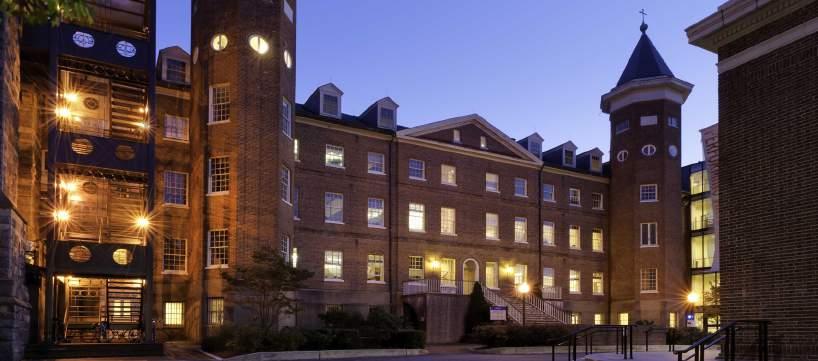
Aamir
HQ and the McCourt School of Public Policy.
elections across the United States and analyzing exit polls.
Elizabeth Wilner, a board member at DDHQ, said the organization pursued a partnership with MPP to generate more awareness about election processes and address Americans’ growing concerns over election security.
“We worry about the growing challenges facing those who administer elections — threats against election officials, threats against poll workers, disregard for the vitally important work that they do,” Wilner wrote to The Hoya.
“The point of our partnership with McCourt, and Georgetown more broadly, is to demystify the work and draw more people into it.”
Sanha Tahir (GRD ’24) said she is
excited to work with DDHQ to learn more about American elections.
“American politics and elections are somewhat new to me, being an international student,” Tahir wrote to The Hoya. “I hope to work in public policy in the future, and I thought this would be an excellent opportunity to rectify this ignorance. What better beginning than being actively involved with the vote counting?”
Claire McDowell (CAS ’27), who plans to pursue MPP’s new joint undergraduate degree in public policy, said she hopes to learn more about data through the internship.
“As someone who is heavily considering pursuing the new
See DECISION, A7
contract with Starbucks and that employees in the Starbucks in Leavey Center are union-represented Aramark dining employees.
“We are continuing to look closely at this important issue,” the spokesperson said.
The panelists discussed their union efforts, the influence of other union strikes like SAG-AFTRA and United Auto Workers (UAW) and the role of union contracts in combating wealth disparities.
Panelist Meghin Martin, a former partner at Starbucks and member of See STARBUCKS, A7
Following two tough losses to Villanova and the University of Connecticut, the Hoyas secured a clutch victory over the Red Storm, 5143, in an energy-packed homestand at McDonough Arena on Feb. 20.
The Georgetown women’s basketball team (17-10, 7-9 Big East) entered its matchup against St. John’s (15-13, 9-7 Big East), looking to regain some momentum as the Big East tournament approaches.
Interim Head Coach Darnell Haney said although the team encountered various challenges en route to the win, he feels confident in his team and their brand of basketball heading into the playoffs.
“We need to stick to our principles and stick to our guns,” Haney told The Hoya. “I think we kind of got away from Georgetown basketball a little bit. I think we tried to make it harder than it needed to be.We just got to go to who we are and what we do and have done
all season and not try to reinvent the wheel and we’ll be alright.”
Georgetown won the tipoff to begin the game, but St. John’s was quick to be the first to score. Although the Hoyas began to settle in offensively toward the middle of the first quarter, turnovers and fouls gave the Red Storm a 13-8 lead by the period’s end.
St. John’s kept this lead for the rest of the first half, as the two teams traded baskets back and forth for the entirety of the second quarter. Former Hoya and current Red Storm forward Jillian Archer (COL ’22) proved to be a threat with 6 consecutive points in the period en route to a double-double game. Though a dominant block from graduate forward Mya Bembry shifted the momentum in favor of the Hoyas, the team still trailed by 3 points at the close of the half at 2320 thanks to a last-second layup by senior guard Kelsey Ransom. Georgetown began the second half with a new sense of fight in
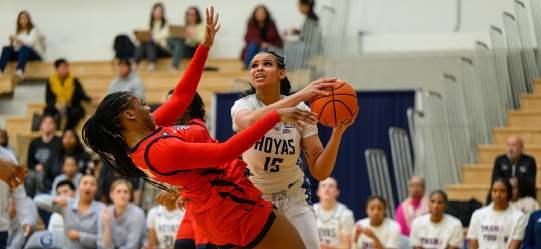
play
The Georgetown Heckler, a humor and satire magazine based at Georgetown University, has faced criticism after members drew butts on their foreheads in Red Square on Feb. 14, in celebration of what they called “Ass Wednesday.”
The Heckler, which is student-run but unaffiliated with Georgetown University, organized the display to satirically commemorate Ash Wednesday, the first day of Lent, a period of 40 days of reflection and fasting. Many Christians attended
religious services and received ashes on their foreheads to mark the beginning of the Lenten season. The Heckler’s board said they did not intend to insult the spiritual meaning of Ash Wednesday or Christians’ religious practices with the joke.
“We think it’s a funny and light-hearted public performance,” The Heckler’s board wrote to The Hoya. “We did not intend to make any statement about the religious significance of Ash Wednesday, or about the character or integrity of people who partake in Ash Wednesday.”
See WBB, A7
The Heckler board members said they did not feel that their actions were discriminatory toward Catholics.
“We don’t really think that Catholicism is seriously threatened by a butt pun made by an university-unrecognized, unfunded club,”
The Heckler board said.
The Heckler’s “Ass Wednesday” gained traction online after Ashley Hayek, the chief engagement officer at a conservative think tank, the America First Policy Institute, posted a picture of the students with butts drawn on their foreheads on X, formerly known
See HECKLER, A7
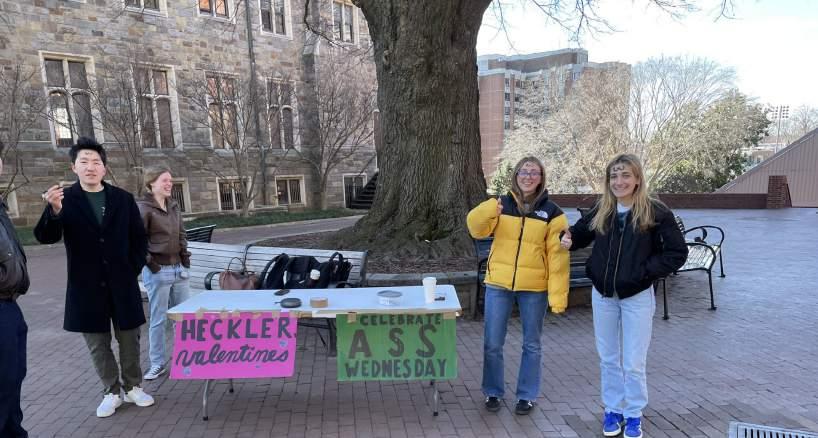
NEWS
GU Politics Advisors
Five new members of the GU Politics advisory board will help oversee the university’s institute for political study.
A6
Inclusive Housing Panel
Student organizations hosted a discussion to push for inclusive housing for LGBTQ+ students.
A6
Resident No. 3
Advice columnist Diane Kim (CAS ’26) offers tips for navigating the friendly-orfraught third roommate dynamic. A2
Fashion Flicks
Kat Mintchev (CAS ’26) describes how expressing self-appreciation through fashion photography uplifts students. A3
Masterpieces Guide columnist Sophia Lu (SFS ’26) spotlights the artistic visions of Studio Ghibli’s groundbreaking founder. B2
A Guide to Ghibli Guide columnist Preston Shirazi (CAS ’27) discusses the directorial, visual and thematic magic of Studio Ghibli. B7
Close, But No Win
Despite a late scoring run, the men’s basketball team fell just short of a narrow victory versus St. John’s, falling 90-85. A12
Victory Deserts Hoyas
At its first-ever MLB Desert Invitational in Arizona, baseball lost all three games it played against top competition. A10
The jury’s out — there’s no trickier situationship out there than being the third roommate. It’s the ultimate “are-we-aren’t-we?” scenario. But before we get ahead of ourselves, congratulations on making it to third (roommate) base! It’s a coveted title that few can brag about, and requires a true friendship with both existing tenants. Or at least enthusiastic endorsement from one and begrudging acceptance from the other. Wherever your particular situation falls on that spectrum, the fact of the matter is that your name’s not on the lease. As with all situationships, the ambiguity of this undefined circumstance can make for some truly gnarly scenarios. For the sake of third roommates everywhere, let’s go over some advice for navigating this quintessential college relationship.
What if I’m really only friends with one of the roommates?: It’s fun to reminisce on how I was rescued from one of the worst dorms in America by my wonderful Copley-residing best friend back in my first year. Like a puppy in a Petsmart, I charmed my way into a warm and loving home — but it took a bit of legwork on my part to convince my best friend’s roommate that I was a) potty-trained and b) a considerate houseguest. A few tips: Do some of the chores. Understand early on what overstaying your welcome means to the roommates; open a line of communication with the other roommate — even if you’re not good friends, you want to be able to check in with them. Finally, never, ever take it as a given that you’re always a welcome guest. It’s the fastest way to become an imposition on someone’s living situation. The nice thing about being a third roommate is that at the end of the day, you have your own room to go back to if you need a little break from certain friends. Being gracious enough to host a third roommate means giving that up to an extent, so be thoughtful towards your friends and their boundaries.
I feel like one/both of the roommates have been in a bad mood when I’m in the room, and I can’t tell if it’s me or if they’ve just had a hard day: This is where that open line of communication — the lifeline of a healthy third roommate relationship — kicks in. In the bestcase scenario, you’re good friends with both your friend and their roommate and can be candid with each other about what it means to share a space. In any case, if you sense that one or both of the roommates are testy or cold, the safest bet is to clear out gracefully and give the room
HOYA HISTORY
some space. Reassess and take a temperature check from a distance. By the way, it’s totally reasonable to check in with the non-annoyed roommate for any necessary status reports before a confrontation! Sometimes the reason really is totally impersonal to you, but always be ready to hear that they’re annoyed with you specifically.
How do I end things with a third roommate?: Okay, how were you supposed to know that your friend is kind of really bad at picking up your signals that it’s time for them to leave? Or that they turn sleepovers into sleepless nights for your early-bird roommate? Whatever the reason, some things just aren’t meant to last forever. First, decide who’s talking to the soon-to-be ex-third. Then, consider how you want to move forward. This conversation about their demotion from third roommate will likely trigger a bigger conversation about your friendship overall. You want to be prepared for this beforehand, and think about whether their incompatibility as a third roommate is a reflection of their incompatibility with you. Finally, the talk: You know how best to confront your friend. Come prepared with what you’re going to say, and try to be compassionate and open minded to how your friend takes it. It’s a hard thing to hear regardless of how you cut the cake, but, with any luck, your friendship will come out the other side stronger.
What if I’m in love with one of the roommates?: I think some condolences are in order. To be frank, all other concerns may pale in comparison to this situation. Weigh the pros and cons of taking your friendship (roommateship?) further, and make your moves accordingly. Or just throw it all to the wind in a Hail Mary to realize your one true love. In cases like this, I don’t actually think advice is all that helpful. Like that therapist in “Fleabag” says — you already know what you’re going to do.
Anyways, if you have any questions, concerns or messy stories you want to get off your chest, you know I’d love to hear them. My inbox is always open — email opinion@thehoya.com or keep your eye on @theHoya on Instagram for the next questionnaire. Bye, you lovelies.
Ciao, d
Diane Kim is a sophomore in the College of Arts and Sciences. This is the second installment of her advice column “Asking for a Friend.”
April 28, 1992
PEPCO into usable power, broke down at 2:30 a.m. Sunday, leaving the main campus library without any electricity. Lauinger was closed all day Sunday, and only the first three floors were open yesterday. Administrators said the power would be restored with a temporary replacement by noon today.
The power outage left the library not only dark, but also without GEORGE, the computerized catalog system.
GEORGE terminals in the Reiss Science Library and the bioethics library in Healy were also inoperational, because the system is based-in-Lauinger.
In order to compensate for Lauinger’s problems, the department of auxiliary services opened Darnall Cafeteria until midnight Sunday, so that students could study there. The Pierce reading room also stayed open until 6 p.m. Sunday and Monday, lit only by natural light.
With the end-of-the-semester crunch in full swing, Lauinger’s maladies caused many headaches for students.
“This is a terrible time of year for this to happen,” said Susan Martin, university librarian, echoing the sentiments of students who had hoped to use the weekend to work on research papers.
“It’s certainly an inconvenient time for the library to be out of commission,” said Jen Himelfarb (SES ’94), who was required to watch the film Cyrano de Bergerac in Lauinger for a
class. “The last week is supposed to be discussion of Cyrano. Now I wonder what we’re going to do.”
But not all was lost, according to Himelfarb. “With the end of the semester crunch, it’s nice to have an excuse not to do anything,” she said.
Other students viewed the power outage as a nuisance. “It’s damn inconvenient,” said Roland Kooch (SBA ’93), who had a final business project due Wednesday and had planned to make several copies and transparencies in Lauinger. Kooch said he went to the library Sunday and yesterday and was disappointed to see it powerless both days. “I thought [Monday] that the maintenance people might be on the ball for once, but they weren’t,” he said.
Suzi O’Leary (CAS 92) said that although she had been inconvenienced by the power outage, “I feel like everyone’s handling it very well.” She said library personnel were very helpful in helping her get books from the first and third floors of the library yesterday that she needed for a paper due Wednesday.
Although some professors considered postponing due dates for papers by a few days because of the dilemma, most said they ruled out (or hadn’t even considered) that option.
Professor Chester Gillis, whose Christianity and World Religions class requires a final paper due Thursday, said he would not yield to any student requests for extensions.
“Since [the paper] has been on the syllabus since the start of the semester, it would be very imprudent to do it at the last minute,” Gillis said.
Martin said yesterday morning that she had not received any criticism about the incident but had heard that students were complaining. “I have heard that there have been some peo-
ple who have taken the attitude that we are somehow to blame,” Martin said.
In defense of the library, Martin said, “We really haven’t done this on purpose.”
Victor Podbielski, director of utilities, said he was: not sure what had broken down inside the transformer. In addition, he said, it passed a routine inspection four months ago. “It’s like the guy who passes his annual physical but then dies of a heart attack,” he said.
Podbielski said a temporary transformer was being shipped to Georgetown from Lexington, KY, and was expected to arrive by midnight last night. After that, crews will work around the clock to get it installed by Tuesday.
“I’m told not to guarantee anything,” Martin said. “But noon is the goal. Even with that, we’re hedging our bets.” Fliers’ posted around campus yesterday, however, said the library’ was expected to open at 9:00 a.m.
After power is restored to Lauinger, Martin said she planned to send a memo to the faculty explaining that the power failure hindered students’ ability to do library research for two days. She added that she thought teachers would be well advised. to. give extensions to students for end-of-semester papers, but added that those decisions would be up to individual professors.
Podbielski said it was unlikely that a similar problem would occur in other campus buildings because they are occasionally inspected, and breakdowns are rare. However, “There’s not a damn thing you can do about it ahead of time unless you put two transformers in,” he said.
As with all situationships, the ambiguity of this undefined circumstance can make for some truly gnarly scenarios. For the sake of third roommates everywhere, let’s go over some advice for navigating this quintessential college relationship.”
Diane Kim (CAS ’26) “Asking for a Friend” thehoya.com
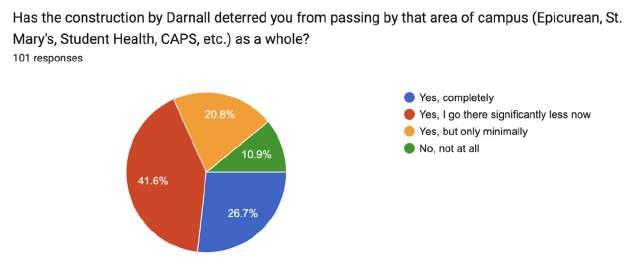
In May 2023, Georgetown University began a revitalization of Henle Village involving the construction of a 780bed complex planned for completion in summer 2025. The project has impacted accessibility on pedestrian pathways near Arrupe Hall, Reiss Science Building, the Leavey Center, Darnall Hall, Epicurean & Company and St. Mary’s Hall. To some students, the construction and the inaccessibility it creates has provided cause to avoid the area. In response, The Hoya issued a poll to 101 respondents
to examine the degree to which the construction has impacted student traffic in that area. A significant portion of respondents — 41.6% — stated that the construction has led them to walk in the area “significantly less,” and 26.7% of respondents replied that construction has deterred them from walking in the area altogether. Furthermore, 20.8% of respondents stated that their routes were only impacted “minimally,” while the remaining 10.9% claimed that they are unaffected.
by Rohini Kudva
Founded January 14, 1920
Michelle Vassilev, Editor in Chief
Evie Steele, Executive Editor Jack Willis, Executive Editor
Caroline Rareshide, Managing Editor
Catherine Alaimo, News Editor
Lauren Doherty, News Editor
Georgia Russello, Features Editor
Hayley Young, Features Editor
Jasmine Criqui, Guide Editor
William McCall, Guide Editor
Lindsay Eiseman, Opinion Editor
Lori Jang, Opinion Editor
Daniel Greilsheimer, Sports Editor
Oliver Ni, Sports Editor
Pallavi Bommareddy, Science Editor
Audrey Twyford, Science Editor
Rohini Kudva, Design Editor
Heather Wang, Design Editor
Caroline Brown, Copy Chief
Evan Ecklund, Copy Chief
Emily Blackstone, Social Media Editor
Toni Marz, Social Media Editor
Alan Chen, Blog Editor
Emily Han, Multimedia Editor
Sofia Nathoo, Multimedia Editor
Max Kurjakovic, General Manager
Riley Vakkas, Director of Business Operations
Sophia Williams, Technology Director
Board of Directors
Caitlin McLean, Chair Ranee Brady, Anya Karumanchi, Ce Mi Lee, Madeline Lee, Henry Liu, James Pocchia
Since its establishment by the NCAA in 2021, name, image and likeness (NIL) has become a significant point of consideration for studentathletes and universities alike when it comes to the recruitment process. These deals, which relate to active endorsements of outside companies, ensure that collegiate athletes receive compensation when brands use their name, image or likeness to promote their products. These agreements also gift athletes with a plethora of complementary products in exchange for their social media promotion. Athletes can receive an NIL deal from various kinds of businesses, ranging from small chains like South Block to major clothing brands such as Vuori.
This is a mutually beneficial relationship: NIL deals help support both the studentathletes and the companies participating in the agreement. Businesses profit from their products receiving this promotion at minimal cost. Given that student-athletes are expected to maintain a public social media presence in order to hold their NIL deals, companies can even garner global advertising.
With regard to studentathletes, NIL deals play a large role in supporting students in their decision to simultaneously further their education while also advancing their athletic career; this encourages more athletes to graduate from their respective universities rather than abandoning their studies halfway through in order to pursue professional sports. As athletes invest more in collegiate sports, university teams in turn grow more competitive and attract more top athletes.
NIL deals also provide an opportunity for studentathletes to maintain a steady source of income in lieu of a part-time job, especially given how time-consuming being a student-athlete can be, with
practices often accounting for 20 hours per week. While NIL deals provide opportunities for companies and student-athletes alike, students who attend larger schools — such as the Southeastern Conference (SEC) and Atlantic Coast Conference (ACC) schools — are at a significant advantage. This is due to the fact that schools of this stature gain more attention from the media, therefore the athletes themselves have more public exposure. As a result, they are more likely to receive larger NIL deals over a student from a smaller school or program.
For example, Livvy Dunne, a gymnast at Louisiana State University (LSU), has several NIL deals — including deals with large brands such as Vuori, an athletic clothing store, that provide her with an annual revenue exceeding $3.3 million in 2023. With Vuori using her name, image and likeness to promote their products, other student-athletes will become increasingly likely to pursue similar deals; however, many cannot.
This is indicative of a greater problem NIL agreements bring: an unequal distribution of resources and benefits. While Georgetown University athletic teams have been able to receive many NIL deals, including South Block, South Moon Under and SPRHRA, they lack facets other schools have tapped into, including TV appearances and large-scale advertising campaigns.
There should be regulations in place to ensure pay and opportunity are equally distributed across collegiate institutions and their studentathletes. No single school or athletic program should have a monopoly over company representation. I urge the NCAA to consider creating a limit on the number of NIL deals a team
or individual can sign with.
On the Hilltop, Georgetown has developed a program called Hoyas Rising that solely focuses on connecting studentathletes and athletic teams on campus with NIL deals in the greater Washington, D.C. area.
So far, Hoyas Rising has helped more than 200 studentathletes and teams find NIL deals from companies in Georgetown.
There is also a new addition of the NIL store through Georgetown Athletics and Hoyas Rising where student-athletes have shirts, sweatshirts and other clothes marked with their names and numbers. It benefits the student-athlete since the money made from selling these clothes goes directly to them, but it also encourages the Georgetown community to rally behind and support their student-athlete peers.
While Georgetown athletics has become more involved in finding student-athletes NIL connections, continuing this growth will not only benefit student-athletes, but also Georgetown athletics as a whole.
Name, image and likeness has opened many doors for student-athletes across the country, and I am confident it will only continue to grow.
I am excited to see what steps the NCAA takes to evolve NIL even further than it is today and where it takes college student-athletes in the future. Ultimately, I can’t wait to see how NIL continues to grow and provide student-athletes more opportunities at Georgetown.
Ashley Kennedy is a sophomore in the School of Health. This is the first installment of her column “Athlete’s Corner.”
You wake up ravenous, but you just can’t stomach the thought of Leo’s. You open Doordash, before remembering that article you read telling you it’s “killing local restaurants.” You could walk to Starbucks, but your friend keeps telling you not to go there, since they’re crushing unions. And Chick-fil-A is obviously off the table, because they’re anti-gay. You sigh, defeated, as you resign yourself to another day of watery eggs or your fifth bowl of vanilla yogurt this week.
Wait. Chick-fil-A is anti-gay, right? Of course it is, at least according to recent calls to boycott the company published in outlets such as Esquire and The Hoya Although Chick-fil-A does have a homophobic history, activists calling for continued boycotts fail to realize the progress the company has made. By calling for a boycott, well-meaning activists continue to fight a battle they’ve already won, hurting the cause for equal rights and distracting from persistent social issues today. Most calls to boycott Chickfil-A begin by describing past homophobic actions from the company and its leadership. Their current chairman, Dan Cathy, once said that gay marriage is “inviting God’s judgment on our nation.”
And for years, the company donated money to homophobic organizations, including the American Family Association (AFA) and Family Research Council (FRC), both classified as hate groups by the Southern Poverty Law Center, a leading civil rights advocacy group. When these homophobic practices came to light in 2012, they justifiably sparked an uproar. Chick-fil-A faced a wave of negative press, and gay rights groups called for protests and boycotts. Politicians took note too, seeking to halt Chick-fil-A’s expansion into cities like Chicago. After a summer of intense
scrutiny, Chick-fil-A caved. They promised to stop donating to organizations with “political agendas,” ceasing donations to groups such as the AFA and FRC. Activists continued to protest Chick-fil-A’s donations to other controversial nonprofits, and in 2019 the company reorganized its donation policy to focus exclusively on “hunger, homelessness, and education.” They now donate over $5 million a year to food banks, college readiness programs and more.
Activists acknowledge that Chick-fil-A has stopped its overtly homophobic practices, but claim that the company’s profits still indirectly support hate. The most recent complaint against Chickfil-A came in a 2021 Daily Beast article, which listed Cathy among Christian billionaires “funding a push to kill the Equality Act.” The Daily Beast supports its bold claim by citing Cathy’s recent donation to the National Christian Foundation (NCF), a nonprofit that grants millions of dollars a year to homophobic organizations. The Daily Beast’s reporting quickly spread to other organizations, sparking renewed calls to boycott Chick-fil-A.
However, unlike traditional nonprofits, the NCF allows donors to allocate their donations over time to specific nonprofits of the donor’s choosing, meaning any grants to homophobic groups were initiated by donors, rather than the NCF. Although this structure conceals which entities finally receive donations, it’s a common method of giving often used to simplify tax filing. It’s unclear which organizations Cathy directed his money towards, but there’s no evidence it was sent to anti-LGBTQ+ groups.
Critics may argue that Chickfil-A’s new policies don’t matter. Sure, they’ve reformed, but only to protect their bottom line.

Everything at Georgetown University unfolds against the Jesuit obsession with living well. Ironically, I never thought much of cura personalis beyond a pipe dream for the university to pack into a brochure for prospective students, benefactors and alumni — until my health tanked last semester and forced me into a medical leave. Now, as I face my body’s limitations, wellness has moved out of my periphery and become the primary concern of my daily life. The place where I’ve found lingering wellness is artistic selfexpression: reconnecting with myself as a writer and starting Added to the File (ATTF), the first fashion photography magazine on campus, with my best friend, Lindsay Khalluf (CAS ’26). Now more than ever, cura personalis appeals to me in its basic definition as the care we give to ourselves and the obligation we have to care for each other as a human collective. Illness has been a harsh reminder for me that wellness begins at the level of the self and the body. It is for this reason that I find it impossible to discuss our mutual wellness as humans without addressing the violence that our society inflicts to erase different bodies. When we consciously recenter the self, we find that the greatest act of dignity onto ourselves is uncovering who we really are and, in the process, celebrating the body by clothing it within an authentic personal style. Any marginalized person experiences Western society as a system of violence that devalues the body into a commodity. In the media, women’s bodies become a collection of parts to be enhanced, concealed and aged backward
with products and procedures.
Black and brown bodies endure the legacy of slavery in all areas of life, such as the ongoing practices of wage theft and an abysmal minimum wage that are attempts to preserve a cheap labor class.
People with disabilities receive financial assistance that is only enough to maintain poverty ($12,140 annually, on average) or are funneled into a workforce that is hostile to different ways of existing. I could continue on, but we know the underlying point — any body that diverts the white/male/cisgender/ heterosexual binary is mutilated (functionally and metaphorically) into something readily exploited by the Western empire.
Obviously, Georgetown and other elite institutions exist at the heart of empire, incubating the next generation of the American corporate and political ladder who are endlessly eager to claw their way to the top. It should come as no surprise that human flourishing is sparse when life becomes a treadmill.
Around this time last year, Lindsay and I started ATTF to feel authentically “well” on this campus within a creative space. Back then, I did not know how much creativity can do to rehabilitate a body that feels fundamentally damaged. But creativity, as Lindsay likes to say, breathes air into the lungs. It is something that I have learned not to take for granted as a motivating force in my life. To invest in the self — and the body — as a source of artistic creation is the highest form of self-respect. In this, I invite us all to think critically about the meaning of a personal style.
VIEWPOINT • HIBBERT AND LANDEGGER
Dressing authentically means recentering texture, color, pattern and difference to our perspectives. It requires us to honor the body rather than attempt to mold it into a caricature of the most current social convention and to heed the cues of sickness and trauma when they arise. In a society that profits from self-immolation, the only way to reclaim the body is to see ourselves as whole, mutable people with the capability for creative expression.
In essence, this is what the first issue of our magazine is about: being confronted with the pressures and brutality of society and choosing to find yourself in it anyway. We invite the reader to view artistic expression as a mirror into the parts of the self that are entirely unique.
At Georgetown, we always circle back to the question of cura personalis. We can mock it, spit on the page wherever we find it and utilize it to criticize this institution that is indeed unendingly reprehensible, but the tenet will remain all the same. I see an opportunity for us to truly “care for the whole person” by recalling the value of the body and our identity. There is an immense privilege, we must remember, in having the means to carve out a personal style in daily life. We would be remiss to pass up the opportunity to dignify ourselves through a genuine appreciation for clothing.
Kat Mintchev is a sophomore in the College of Arts and Sciences. This is the first installment of her advice column “Asking for a Friend.”
The organization is still run by a homophobe who has never disavowed his previous beliefs, so no moral person should eat there again.
These critics are right — Chickfil-A likely changed its donation policies for purely economic reasons. But the company took a risk by changing its donation policies and offending some rightwing customers. After Chickfil-A’s 2019 donation overhaul, 120,000 people signed a digital petition from the AFA, accusing Chick-fil-A of having “caved to the LGBTQ+ activists and their illegitimate complaints.” The Family Research Council accused the company of “waving a white flag on God’s truth.”
Chick-fil-A likely predicted this backlash, but still made these changes because they believed they would win back more business from gay rights supporters than they’d lose from bigots. If gay rights advocates permanently withhold our business from Chick-fil-A, we’ll send the message that stepping away from hateful causes was a mistake, and companies will be less likely to listen to our demands in the future.
Maybe you’ll still choose not to eat at Chick-fil-A. You have the right to pick the companies you support, and I respect you for standing by your convictions. But before you try to rally support for your cause, consider whether it’s worth the cost of diverting our collective bandwidth away from other pressing issues. So please — keep fighting for equal rights. If you pick the right battles, you can make a real difference.
Nate Morris is a first-year student in the College of Arts and Sciences
It is a well-known fact that students in Georgetown University’s McDonough School of Business (MSB) do not have a language proficiency requirement. This exception to Georgetown’s core language requirement is often weaponized against business students in order to point to their lack of work ethic and light workload. As repetitive and reductive as these jokes can be, when it comes to the language requirement, they’re right.
A school that prides itself on “global business knowledge” should not skimp out when it comes to building communication skills. Rather, the MSB and its administration should make a substantial effort to promote language learning so as to shape a new generation of global business leaders.
The era of reliance on the English language as a key to unlocking the world is coming to a close. While the United States is by no means losing its status as a global hegemon, its influence on the global economy is decreasing as other countries rise up through rapid development and growth. Multi-language proficiency is becoming more necessary than ever; the flexibility it allows in business settings cannot be understated. In as global of a city as Washington, D.C., language is the most valuable form of knowledge. The absence of this MSB requirement is a disservice to its students and their future. It is essential to incorporate a language requirement into the MSB curriculum in order to improve students’ communication skills, resumes and brain function. As the most spoken language in the world, English is undoubtedly necessary for success in the professional world. However, other regions such as Asia and
the Middle East are starting to take center stage in terms of language importance.
Mandarin, the second most spoken language globally, is increasingly important in the business world due to China’s growing economic influence and the vast opportunities it presents for international trade and partnerships. The third most spoken language, Hindi, is already highly prized by U.S. government agencies and the business market, and both Chinese and Hindi are designated critical languages by the U.S. State Department.
Proficiency in a second language facilitates connections with international clients, partners and colleagues. Business negotiations often require the nuance of foreign languages and cultures, and adding a language proficiency requirement would allow students to build rapport and negotiate more successfully across different cultures.
Learning a language is also proven to have various cognitive benefits. For example, multilingual students performed two to three times better on reading and math exams compared to students who knew only one language, according to a study performed at New York University. A study published in the Journal of Language, Identity and Education found that multilingual students performed better in all subjects. Besides academic performance, multilingual individuals demonstrate a greater ease in learning, complex thinking, creativity and mental flexibility, all of which are important to a successful career in business.
Not only does multilanguage proficiency have countless benefits, but we personally believe that it is
disrespectful to not learn any language other than English. It assumes a position of unspoken superiority over anyone you’re communicating with, as if they must cater to you simply to have a conversation. Any second language proficiency is good, whether it’s an obscure language or a globally spoken one. We believe that the act of learning and mastering a new language is an important developmental challenge that cultivates an appreciation for languages and communication overall. Ignoring this challenge and relying on English dampens creativity, demonstrates carelessness and reduces opportunities.
In order to truly stand by its mission statement, the MSB must incorporate a language proficiency requirement. The opportunities provided to multilingual job seekers greatly outnumber those provided to monolingual applicants. Furthermore, enhanced worldwide communication allows for flexibility and fluidity in a business setting.
Reliance on English as a global language is outdated and egotistical; to expect others to learn your language when you do not bother to do the same is disrespectful. The incorporation of a language requirement similar to that of the School of Foreign Service would greatly benefit MSB students in current and future endeavors. We must adapt to the current global economy by becoming global ourselves.
Charlotte Hibbert is a first-year student in the College of Arts and Sciences. Luke Landegger is a first-year student in the McDonough School of Business.
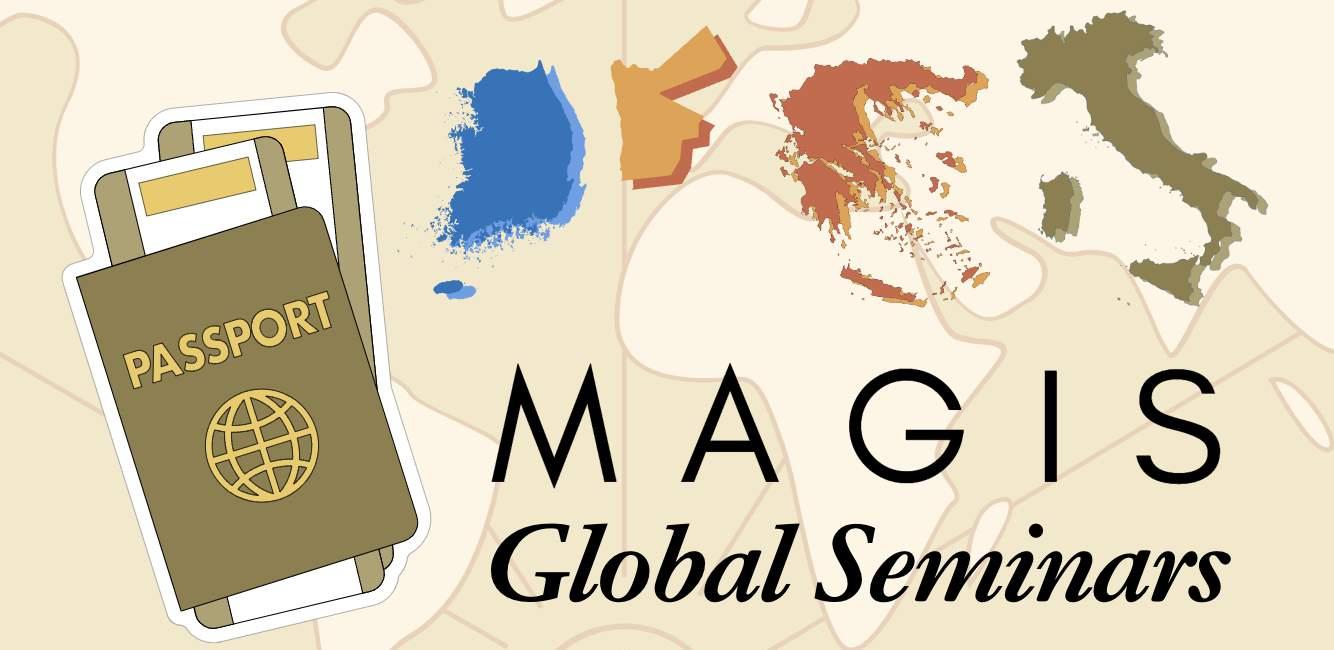
ILLUSTRATION BY: JACK WILLIS/THE HOYA
Students from four Georgetown undergraduate experiential learning classes will spend spring break traveling to Italy, Greece, South Korea and Jordan to study issues of international religious dimension.
Jack Willis Executive EditorAthe United States and Eurasia, including to Italy, Greece, South Korea and Jordan this year, as well as Nepal, Jerusalem and the southern United States in years past.
On the Hilltop, undergraduate Hoyas can choose from a plethora of offerings in the Theology and Religious Studies Department, including the two courses required of all students — an introductory course and an upper-level elective.
According to Fr. Mark Bosco, S.J., who designed the Magis program and serves as vice president for mission and ministry, the seminars — which are backed by an extensive fundraising effort — seek to expand on existing in-classroom conversations through on-the-ground immersion at religious sites and cultural centers.
“I’m an academic by training, and so I wanted to see if I could connect the spiritual and the intellectual in a really impactful way, and they got on board,” Bosco said. “So we never know how many we’re going to do, depending on how much money we can raise.”
Pilgrimage, Tourism and Community Bosco, whose experience teaching summer courses in Italy inspired him to imagine ways to develop short-term but similarly immersive experiences, said service and connection are two central components of the Magis program, which he said encourages students to view their trips as pilgrimages encompassing not just academics, but personal and spiritual reflection.
“We are situated here in D.C., but we’re looking to say, ‘How can we serve the world?’” Bosco told The Hoya “And to serve the world is to not just have a bucket list of places to go, but to serve it. We say that a tourist goes through a place, but a pilgrim lets the place go through them.”
Bosco, who has researched and taught extensively about Rome, said intimate moments of personal reflection often arise in small group settings where students — like his group of 15 in Italy in 2023 — can embrace the idea of pilgrimage in connecting with places or objects
like the tomb of St. Peter, an early Christian saint buried in Rome.
“I was with a group of students, and we’re like, three to four feet from the bones of St. Peter, and a student just knelt down, and all the other students didn’t know what to do,”
Bosco said. “And they also knelt down, and everybody was crying, because it was a very emotional thing.”
“But coming out of that we had a pranzo, a lunch, and we just talked about that — it’s just an emotional moment,” he added.
“To be able to share that moment together was really quite lovely.”
Renato Llontop Calosi (SFS ’24) was
“We say that a tourist goes through a place, but a pilgrim lets the place go through them.”FR. MARK BOSCO, S.J. VP OF MISSION AND MINISTRY
among the first class of post-lockdown Magis students, attending a summer immersion in northern Spain that followed in the footsteps of the pilgrimage of St. Ignatius of Loyola, the founder of the Jesuit order.
Llontop Calosi, whose Spain trip marked his first to Europe, said the structure of the seminars enables students to move beyond tourism and into an immersive personal reflection.
“When we are pilgrims, we like to say that it’s not just like we are tourists, but we’re actually more grounded into some sort of spiritual trip,” Llontop Calosi told The Hoya. “For the life of St. Ignatius, it was more for me to understand where does the Jesuit identity or those Jesuit values connect to Georgetown? Why are they so important to them?”
As a Catholic university affiliated with the Jesuit order, Georgetown prides itself on values of interfaith dialogue, spirituality, service and leadership.
The year following his trip to Spain, Llontop Calosi traveled to Rome with Bosco for a Magis seminar on the city’s history. As a second-year pilgrim, Llontop Calosi said his immersion was multifaceted, encompassing faith, culture and language.
“It was not just an immersion with faith because of course there’s a lot of culture that you can also explore in many of these trips,” Llontop Calosi said. “I think it’s a good combination, at least, in which you can see religion, you can also see culture, you can also see society.”
Abigail Bettendorf (SOH ’26) will travel with Anton and Ori Soltes, a professor of theology and Jewish civilization, to Greece. As an ESCAPE leader guiding first-year students on reflective retreats, Bettendorf said she hopes to think about her own pilgrimage.
“I hope that going to the places in Greece that Paul wrote to, as well as where his missionary activities took place, will help me to better understand these texts that are so influential and have become incredibly important to me personally as I grow and mature in my Christian faith,” Bettendorf wrote to The Hoya “I’m excited to walk in his footsteps and pray that, in doing so, the Lord continues to stir up in me the motivation to live the faithful life that Paul described and share this hope and faith that I have with others like Paul did,” she added.
A chaplain accompanies professors and students in each seminar, an aspect of the program which Bosco said sets the Georgetown programs apart.
“We will get to know each other on the Hilltop,” Bosco said. “Then let’s travel together, talk to each other, learn about the history, faith, culture and do it as a group and come back.”
Bosco said he invites course ideas from professors, and this year, MinAh Cho, a theology professor, will lead a group of 14 students to South Korea. Cho said she first proposed the idea during a meeting with Bosco, who proved immediately receptive.
“Last December I visited Korea and came back, and I had a meeting with Father Bosco,” Cho told The Hoya “I shared my interest in offering a course like this, and then Father Bosco found it really exciting and interesting, and he said, ‘Why don’t you do offer it for the spring semester?’”
Similarly, Cho said she has been in close contact with the Jesuit order in South Korea, who she said have been hospitable and helpful in making arrangements for cross-cultural engagement.
“In each place, I have been working with Catholic groups and activists, so they are collaborating with us in many different ways — offering housing and preparing for food and meeting,” Cho said.
Seminars, Social Justice
Nearly 60% of Georgetown undergraduates study abroad — an endeavor which requires students to pay full tuition, with applicable financial aid, plus costs of travel and living expenses.
With the Magis seminars, however, Bosco said he prioritizes inclusivity, and that his fundraising efforts fully covered the costs of seven trips in 2023 alone, taking students to destinations across Europe and the United States.
He said the program seeks to engage students with financial need, including members of the Georgetown Scholars Program (GSP), which serves first-generation and low income students.
“We really try to engage our students on scholarship because they probably won’t have the means, perhaps, to go away for an entire semester abroad,” Bosco said. “Anybody who signs up who’s GSP, for example, they’re highly considered for the class.”
Anton, echoing the importance of going abroad, said he hoped the program would allow student pilgrims to
expand their perspectives and connect with course material.
“Some students in this class are going because they didn’t have a chance to go abroad,” Anton said. “This is their chance to go abroad. So for that, it’s good for them because they will get out of the country. They will see different ways of doing things. Hopefully, some of the themes from St. Paul will also come across as they do this.”
Financial need is not the only factor in seeking to broaden student engagement, according to Bosco. Particularly for students under the Deferred Action for Childhood Arrivals (DACA) program, which protects undocumented immigrants who arrived in the United States as children from deportation, immigration status can be a barrier to travel. People with DACA status must take additional steps to travel abroad, and requests to the federal government are not always granted.
Bosco said he planned a domestic seminar so students whose immigration status may inhibit international travel would still be able to make a pilgrimage.
“We did a civil rights pilgrimage to the South,” Bosco said. “That one we did especially because we wanted to make sure that students who were DACA or could not leave the country had an opportunity to do one of these as well.”
The curriculum of Magis seminars also focuses on elements of social justice, not just religion and pilgrimage. Cho, who grew up in South Korea, said her first-hand experiences inspired her to craft a course outline and itinerary that surveys both the nation’s painful history and its hope for a brighter future.
“When you actually go to Korea, we see and find the hope and joy through our meeting with the people living there,” Cho said. “People who have been working diligently for the peace and justice of the country, and people who want to make connections and
Roughly 60 Hoya undergraduates will add stamps to their passports next week while voyaging on Magis immersion seminars.
who already stand up for the justice and democracy of the country.”
Immersion in Theology
As a previous pilgrim to the Sea of Galilee, Anton said being in the real-life setting of biblical stories changed the way he engages with such passages.
“So when you’re there, and then you’re on the spot, you’re having the water from the Sea of Galilee wash up on your feet, and you read the story,” Anton said. “And as you read the story, you say, this is exactly the way it looked when Jesus was here.”
“This is the water, the shore, this is exactly it — that changes it every time you read that story from then on for the rest of your life.”
Anton said his past experience on pilgrimage has taught him that physical presence goes a long way in terms of enriching texts that students have studied only in a classroom setting, which he feels will be particularly impactful in Greece.
“This is where Paul stood in the Agora in Athens when he wrote this,” Anton said. “And we’re going to do that and reflect on it.”
Llontop Calosi, who is in his final year at Georgetown, will attend a Magis seminar in Jordan that surveys interreligious interactions. He said this trip is markedly different from his first two in that it moves from history into modern diplomacy and politics.
“Jordan allows you to see not just the faith component, but how diplomacy with faith is being applied, how education is being applied, how policies are being applied, how economic-wise, faith literally overlaps with many different branches or with many different sectors within society,” he added.
In addition to the Magis seminars, Georgetown offers students opportunities to travel for spring break with the School of Foreign Service’s Centennial Labs (C-Labs), which similarly take undergradu-
ates abroad for experiential learning.
Sydney Freed (SFS ’26) will travel to Cairo, Egypt, for a course on cultural heritage and its resonances in the Arab world, and said the opportunity will allow her to self-reflect — in particular through connecting with students at an Egyptian university, much like Cho’s students will do in South Korea.
“I think in classes, especially ones that push me to move outside of my westernized experience, to just pause and think, this is not bad or negative, but, ‘How can I think about the way that I have things framed in my mind?’ and then think about, ‘What are alternate ways to approach this subject matter?’” Freed told The Hoya
“Because when you look at history, it’s obviously not objective,” Freed told The Hoya. “So what are the different subjective ways people think about it, and how can that help me develop a more well-rounded view of what we’re talking about?” she added.
Cho said studying the complex, often painful aspects of Korean religious history will prepare students to engage with theological issues and reflections in a new, enlightened manner, much like how the Christian Lenten season prepares believers for the joy of Easter.
“Looking into the darker parts, when you go to Korea, through our meeting with the people, activists, students and scholars, I want students to experience a kind of hope and resurrection,” Cho said.
As a professor, Cho said she hopes her students walk away with a transformative experience that echoes far beyond their week in South Korea.
“The immersive experience it offers is just an amazing experience to students who learn things not only through books or through their brain, but the immersive experience encourages them to take their experience into their heart,” Cho said.
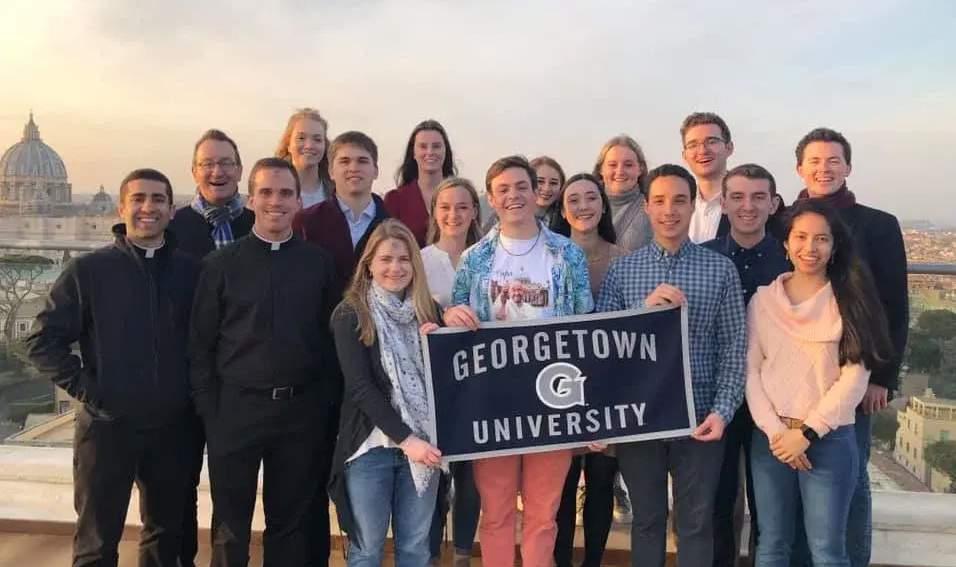
“Beyond the Light,” an exhibit at Artechouse, an innovative art museum located close to L’Enfant Plaza, immerses visitors in projections of images from billions of light years away.
The exhibit features floor-to-ceiling, wall-to-wall imagery of galaxies, nebulae and other distant parts of the universe captured by the James Webb Telescope, the largest telescope ever placed in space. While visiting Artechouse, space enthusiasts can also enjoy interactive experiences throughout the museum that explore the moon, climate science, other NASA technologies and heliophysics, which is the study of the sun and its interaction with the solar system.
Hector Castillo, visitor experience host at Artechouse, said that the museum’s use of cutting-edge technology for its exhibits is what distinguishes it from traditional art museums.
“I think that our use of technology really sets this museum apart,” Castillo told The Hoya. “If we didn’t have this collaboration with technology, Artechouse would be like any other
museum. Not that that’s a bad thing — just as technology develops, we are trying to develop with it.”
The exhibit, which was developed in collaboration with NASA’s Goddard Space Center, the James Webb Space Telescope Mission team at the Space Telescope Science Institute (STScI), and Johns Hopkins University’s William H. Miller III Department of Physics & Astronomy, closes March 3.
The museum’s main room displays a 26-minute long series of images of the cosmos, taken by the James Webb Telescope and enhanced with artificial intelligence technology. Some of the images include galaxy NGC 2525, which is located 70 million light years from Earth, and galaxy NGC 628, which is located 34 million light years away from Earth.
Eda Toprak (CAS ’26), a recent visitor to Artechouse, said her experience at the exhibit was engaging and impactful, especially her time spent in the main projection room.
“It was in a way peaceful because it made me feel like I was in space,” Toprak told The Hoya Castillo said that the use of immersive projection technology allows visitors to fully grasp the recent
advancements in space exploration and maximizes visitor education.
“The immersive technology allows people to see how far space science has come,” Castillo said. “When people can place themselves within the exhibit, they want to learn more about it.”
Laura Betz, the communications lead for the James Webb telescope, said in an online NASA article that NASA helped design “Beyond the Light” to display the profound discoveries of the telescope.
“What’s so amazing about the James Webb Space Telescope is that the whole world came together to build it,” Betz said in the article. “The images that this remarkable machine delivers to all of us from space remind us of our connectedness to each other.”
Toprak said the educational elements in the exhibit are geared toward people of all interests, not just science and astronomy lovers.
“I would definitely recommend the exhibit because if you are a science person, there is a lot of information to take in, in terms of planets and moons of planets,” Toprak said. “And if you are not a science person, you can still enjoy the visuals and auditory effects.”

The exhibit has seen major success since its opening Sept. 15, which has caused Artechouse to repeatedly extend the closing date of the exhibit, according to Castillo. Castillo said he believes that a large part of the exhibit’s appeal comes from the collaboration with NASA’s Goddard Space Center, a hub for scientists and engineers who build instruments designed to study the Earth and its celestial neighbors.
“When people hear NASA, their curiosity spikes, just because of
Arumani
SahanaDeputy Science Editor
A Georgetown University neuroscience professor discussed her research on motor pathways at the Georgetown University Medical Center on Feb. 20.
The department of biochemistry hosted the talk on neuroscience research as part of its Bhussry Seminar series, weekly research talks hosting scientists from various institutions including Georgetown. The event featured Rebekah Evans, assistant professor in the department of neuroscience, who presented her work on motivated behaviors.
Evans’ research focuses on a motor pathway that originates in the basal ganglia, a part of the brain involved in voluntary movements, learning and motivated behaviors. In addition, the basal ganglia is associated with Parkinson’s disease.
Evans’ work concerns the substantia nigra pars reticulata (SNr) and globus pallidus externus (GPe) — two parts of the basal ganglia — and their interactions with a region in the brainstem called the pedunculopontine nucleus (PPN), which is also involved in movement and is impaired in Parkinson’s patients.
According to Evans, the SNr and GPe both inhibit the PPN by releas-
ing an inhibitory neurotransmitter, a chemical signal between neurons. Evans said her research focuses on the mechanisms underlying these two inhibitory connections.
“‘Why does it have these two output pathways that can both modulate movement but through completely different mechanisms?’” Evans said at the event. “Well, we wanted to understand a little bit about how that was working.”
To begin to understand the SNr and GPe connection to the PPN, Evans’ team injected mice with a protein that activates neurons. Evans hypothesized, based on existing literature, that stimulating the SNr would inhibit movement while stimulating the GPe would increase movement — but found the opposite. The SNr increased movement while the GPe inhibited movement.
“It’s not our second hypothesis, that they might do the same thing because they’re both inhibiting the same structure,” Evans said. “They’re actually doing opposite things, even though they’re both causing inhibition.”
Evans then investigated the manner in which the SNr and GPe interact with the brainstem to carry out opposite movement behaviors.
“So we want to ask two questions,” Evans said. “One is, ‘Do these two
structures of the basal ganglia inhibit different parts of the PPN anatomically? Or do they inhibit different cell types that are molecularly defined there?’”
To further investigate the connections between these brain regions, Evans’ team performed electrophysiology experiments, stimulating mouse brains with light then measuring inhibitory currents to three types of neurons in the brainstem.
Evans found that the SNr and the GPe connect to different neurons in different regions of the brainstem.
The SNr connects to two types of neurons called cholinergic and glutamatergic neurons in both the front and back of the PPN, while the GPe connects to only glutamatergic neurons in the back of the PPN.
“The GPe connecting only to the glutamatergic neurons is really interesting,” Evans wrote to The Hoya “We don’t know the full extent of its significance yet, but think that this output pathway from the GPe to the brainstem is a way for the GPe to directly modulate motor activity.”
Evans’ team found that a certain set of neurons, known as glutamatergic neurons, were vulnerable to both SNr and GPe inhibition. Evans said her team aims to work on distinguishing the differences between those neurons’ interactions with the
SNr and the GPe. “We don’t know for sure if these are inhibiting motion or enhancing motions to begin with,” Evans said. “So that’s one of our next steps as well.” Evans said that teasing out the connections between the basal ganglia and the brainstem is a stepping stone to improving deep brain stimulation, which can help alleviate some symptoms in Parkinson’s patients.
“The PPN is sometimes targeted for a Parkinson’s Disease therapy called Deep Brain Stimulation,” Evans wrote. “If we understand the connections between the basal ganglia and the PPN, we can develop more precise stimulation locations and stimulation patterns to optimize Deep Brain Stimulation treatment.”
Stella Alimperti, an associate professor in the department of biochemistry and molecular and cellular biology at Georgetown’s School of Medicine, attended Evans’ talk and said that Evans’ work on motor pathways will have implications for furthering the understanding of neurological diseases.
“The most important part is really to figure out the key molecules that are involved in diseases, like neuro diseases such as Parkinson’s disease, and really the novel methods that she is trying to develop and use,” Alimperti told The Hoya
“We didn’t even think about particulate matter or the fact that we were breathing this in as children. It was more of that, if it fell on your clothes and you touched it, it would actually stain, so you would have to blow it off.” Njoko previously worked with the Environmental Protection Agency (EPA) and Washington, D.C.’s, Department of Energy and the Environment before switching to the corporate side of sustainability, working for the clothing company Kontoor before her current role at Ralph Lauren. Nkojo said she enjoys the wide range of opportunities that her career in sustainability provides, as it has allowed her to work on a variety of different projects and initiatives in seemingly disparate fields.
garment’s carbon footprint.
“I found it really interesting how she noted life cycle analysis and innovation as key parts of where fashion is heading,” Johnson told The Hoya. “There are always going to be different parts of innovation where science and direct textile design need to be combined, and most of the time, it is not the people designing these clothes that have a direct science background.”
Vishal Agrawal, the Henry J. Bloomer endowed chair in sustainable business, academic director for the Business of Sustainability Initiative and the moderator of the event, said Nkojo’s experience and expertise provide valuable lessons for those interested in sustainability.
sustainability guidelines, with consumers buying for longevity and fashion brands making trendy products more easily recyclable.
“Buy for longevity, buy and hold on and care for the products that you have,” Nkojo said. “But then for stuff that’s trending, like bell bottoms are in, if you’re gonna wear bell bottoms — and we all know that’s not going to be the thing next year — those things should be easily recyclable, the jibbitz, the trims, the zippers should be easily removable, so that denim can be recycled.”
Nkojo noted that one such innovation in textile recycling is the development of dissolvable threads, which degrade at lower temperatures than standard threads and allow for more efficient clothing recycling.
what the company is and has done,” Castillo said. While past Artechouse exhibits, such as “Life of a Neuron” and “Kingdom of Colors,” have also embodied the intersection of art and technology, Castillo said that “Beyond the Light” offers the most amount of scientific information in any Artechouse exhibit to date.
“With other exhibits, there’s more of a focus on the artistic side of things, but with ‘Beyond the Light,’ there is such a natural beauty in the photographs from the James Webb
Telescope that we can focus more on the science,” Castillo said. “A lot of that is due to the collaboration with NASA because there are so many great minds to provide us with all sorts of information.”
Castillo said he hopes the exhibit’s success will serve as a catalyst for future exhibits synthesizing technological advancements with accessible designs.
“I think that this exhibit is setting a really high standard for Artechouse and is hopefully indicative of what’s to come,” Castillo said.

The Washington, D.C. Metro trains are seen by many as a sustainable alternative to driving when it comes to reducing carbon emissions, decreasing the amount of carbon-emitting vehicles on the road. According to the National Institutes of Health, subways reduce air particulates by about 4% in highly populated areas like metropolitan D.C. Despite associated popular sentiment, the environmental impact of Metro trains is not so clear-cut. While subway trains seem to be relatively environmentally friendly on the macro scale, the pollution levels of individual subway stations remain high, posing health risks, especially for those who often have no choice but to rely on the subway for transportation.
Research shows that people are being exposed to unsafe levels of pollution in subway stations across major U.S. cities, but the problem is especially concerning in the District. Researchers at New York University Langone Health explain that this pollution is due to factors such as poor ventilation in stations and debris from the skidding of train wheels on the track.
commuters, these dangerous pollutants also affect those who work in the subways. Workers such as cleaners, train operators and security guards inhale this particulate matter for hours every day, meaning their exposure levels — and consequent health risks — are considerably higher than those of commuters.
Fortunately, there are mitigation efforts that can and should be made to better the subway station air quality of the District and of U.S. cities as a whole.
For example, the Washington Metropolitan Area Transit Authority already filters the air in its buses and trains, which rids the air inside the vehicles of 98% of pollutants. While this is great news, it still does not account for the air in the stations themselves. Of course, in order to remedy this situation, large-scale efforts would have to be made, such as making the switch to electric trains or
portunities and outreach events such as the speaker series.
Njoko said she was first drawn to the environmental justice movement because of her experience growing up in Hunts Point, N.Y., a neighborhood in the Bronx with abnormally high pollution rates and, consequently, the highest concentration of asthma in New York City.
According to Njoko, although she often witnessed severe pollution while living in the Bronx, she did not fully understand the dangerous health effects of breathing polluted air at the time.
“I started to remember we would be playing outside and the local incinerator would burn trash and it would rain soot on us,” Nkojo said at the event.
“Here I am an environmental justice person, and all of a sudden, I’m running a job training program and a loan program,” Nkojo said at the event, referencing her time at the EPA. “That’s one of the things I love about the work in what is now sustainability is that it’s so intersectional.”
While executing Ralph Lauren’s sustainability and circularity strategy, Nkojo helped implement circular design principles, sustainability and circularity certification requirements, as well as a cashmere recycling program.
Nkojo also stressed the importance of resourcing, saying current pieces of clothing can be resources for crafting sustainable, circulatory products in the future.
“The idea is, resourcing the material that is already in your clothes can be our sources for the future,” Nkojo said. “My inventory is sitting in your closet.”
Whitney Johnson (CAS ’24), who attended the event, said she appreciated Nkojo’s intersectional approach, especially her focus on science-driven sustainability initiatives like life cycle analysis, a scientific calculation of a
“Danielle’s extensive experience in circular economy strategies from the government to private sectors, provides insights for how such strategies can be adopted to provide both economic value and lower environmental impact,” Agrawal wrote to The Hoya. “These and our other events and initiatives forge innovation with leadership, making Georgetown McDonough one of the most thought-important leaders in sustainable business.”
Nkojo said that initiatives like Cradle to Cradle, a chemical standard that companies use to innovate new materials with minimal environmental impact, are effective collaborations between science and the textile industry, although such plans to salvage textiles can be difficult to implement.
“I love these new ideas, but certainly they need to be scalable, and the sources of the material to make them need to be nontoxic as well,” Nkojo said. According to Nkojo, both consumers and companies should bring their purchases and products, in line with
By implementing these threads into a garment’s stitches, which traditionally are made of non-recyclable elastane thread, Njoko said that fabric from discarded clothing can be used to make new garments, reducing their environmental impact.
“Science is playing such a large role in this space,” Nkojo said. “One of the things that I am excited about is the idea of dissolvable threads. If you all are studying what you’re studying, you’ve seen that picture of the jeans that have been composted, and what’s left are the elastane threads.”
Returning to her motivations for working in the sustainability industry, Njoko said implementing sustainability and circularity systems can have a tangible impact on affected communities such as the one she came from.
“If I set up these circular systems, I know that there’s not a kid in the Bronx having soot raining down on them because we see the value in the materials,” Nkojo said. “When you think of it as a resource, it’s helping to do my part and have an impact.”
When measuring for the amount of fine particulates — pollutants with a diameter of 2.5 micrometers or less — in the subways, the District was found to have levels of 145 micrograms per cubic meter, well above the 35 micrograms per cubic meter that experts usually regard as being safe. Out of the regions studied by researchers at New York University Langone, air pollution levels in D.C.’s Metro stations were second only to the subway stations of New York City, with D.C.’s Capitol South station being one of the most polluted stations in the Northeast. Continual exposure to air pollution has been linked to adverse health effects, such as stroke, ischaemic heart disease and lung cancer. This is especially true of exposure to fine particulate matter, such as the type being seen in subways systems throughout the nation, due to their ability to penetrate deep into the lungs and therefore the
“The issue of subway station pollution will inevitably require collaboration between policymakers, health specialists, transportation authorities and the community at large to safeguard the health and safety of the public.”
trains that run on renewable energy in the same way that cities like Tokyo have. Unfortunately, due to various political and economic factors, such as the cost of electrifying trains and lobbying by rail companies like Norfolk Southern, it is unlikely that this switch would be made anytime in the near future.
In the meantime, the Metro buses can serve as an effective alternative to the trains, with outdoor stations reducing exposure to pollutants. Additionally, 90% of D.C.’s bus fleets now consist of hybrid vehicles, an effort to keep the air clean. Ultimately, the issue of subway station pollution will inevitably require collaboration between policymakers, health specialists, transportation authorities and the community at large to safeguard the health and safety of the public.

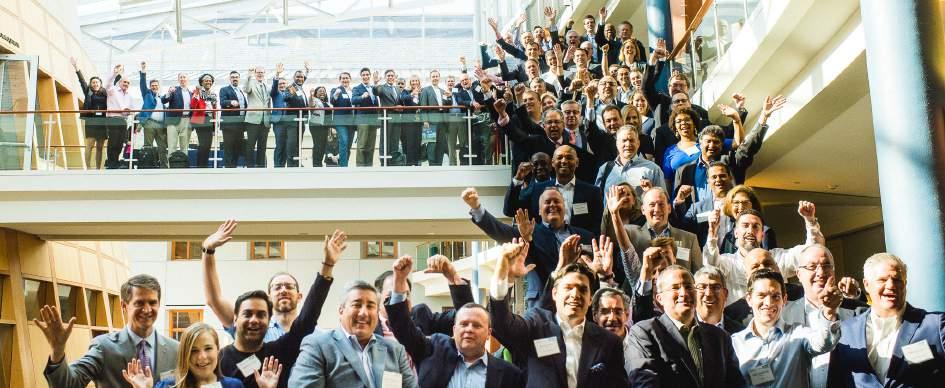
Maren Fagan Academics Desk Editor
General Mark A. Milley, formerly the nation’s highest-ranking military officer, will serve as a Distinguished Fellow in Residence in the School of Foreign Service (SFS) beginning this semester, according to a Feb. 13 press release.
Milley is the former chairman of the Joint Chiefs of Staff (JCS), a collective body of the highest-ranking military members in their respective branches whose chair is the highest active-duty military position in the United States. Milley will begin his role in the Security Studies Program (SSP) this semester alongside a concurrent position working at his alma mater, Princeton University, as a visiting lecturer and professor at the School of Public and International Affairs.
Milley said he looks forward to contributing to the Georgetown University community during his retirement.
“I am excited about the opportunity to make a contribution at Georgetown and help shape our National Security leaders of the future,” Milley said in the press release. “Georgetown’s School of Foreign Service is world class and joining such an accomplished group of faculty and staff is truly humbling.”
As chairman of the JCS, Milley was the principal military advisor to the president, secretary of defense and National Security Council from October 2019 until September 2023. Air Force General Charles Q. Brown Jr. succeeded Milley in October.
Prior to becoming the chairman of the JCS, Milley was the U.S. Army’s chief of staff, its highest-ranking officer. He also served as commanding general of
the U.S. Army Forces Command, the largest U.S. Army command that trains and prepares forces.
SFS Dean Joel Hellman said the school looks forward to having Milley join the SSP.
of the Latinx community.
GU Pride, a student organization for LGBTQ+ students, has been involved in discussions with the administration and students about creating more inclusive housing on campus.
Liam Moynihan (SFS ’25), former president of GU Pride and the club’s director of advocacy, said that Georgetown’s current housing system limits nonbinary students’ choices of roommates, which often places them in uncomfortable situations.
“You get told you can either live with men or you can live with women, or maybe you can
“I think that he’s a great resource for students, for individuals or small group meetings because it’s really the best way to learn.”AVA WASSON (SFS ’24) ROTC LEADER
“We are excited to welcome General Milley to the School of Foreign Service,” Hellman said in the press release. “His lifetime commitment to service in the interest of our nation’s security will surely inspire our students and enrich our community.”
At the SSP, Milley will advise faculty on topics of national security and serve as a resource and mentor for students interested in military and security studies while supporting the broader Georgetown community.
Daniel Byman, the director of the SSP, said Milley’s experience with understanding and creating policy for security issues will be valuable for the SSP.
“General Milley’s first-hand experience grappling with the world’s toughest security issues will be invaluable for Security Studies Program (SSP) students seeking to understand the challenges of the world today,” By-
live alone depending on the availability of a single. But particularly living alone is far from guaranteed,” Moynihan told The Hoya. “It’s presented as totally my choice, but what do I have to choose between?” Moynihan said that even transgender students who identify within the gender binary may be put in uncomfortable or dangerous situations, particularly when being randomly assigned a roommate. “With any kind of random assignment, you have no idea if a roommate is going to be transphobic,” Moynihan said. “It’s a very sensitive identity to have in terms of living in a space with another person.” “Even for trans students able to live in a space with the gender they identify as, there are a lot of difficulties that arise with regards to safety and feeling comfortable and at home in your space,” Moynihan added.
Marre Gaffigan (CAS ’26), who identifies as nonbinary, said that living with other transgender or nonbinary students would create an immediate sense of community that is key for cultivating a safe living environment.
“Even in any other sector of the LGBTQ community, gender identity and expression kind of
man wrote to The Hoya Ava Wasson (SFS ’24), a leader in the Georgetown Reserve Officers’ Training Corps (ROTC) will begin commission for the Army in May as a military intelligence officer. Wasson said she believes that Milley will serve as an important opportunity for students to have exchanges between service members and civilians.
“I think that he’s a great resource for students, for individuals or small group meetings because it’s really the best way to learn,” Wasson told The Hoya “I’m sure that General Milley’s experience will be applicable to what they’re learning, and they can ask about his experience.”
“I think it’s a really great thing the SSP is doing,” Wasson added.
Heidi Urben, a retired Army colonel and professor in the SSP who has previously worked with Milley, said the SSP anticipates Milley’s new role will engage students interested in national security.
“We look forward to General Milley engaging with SSP students both in and out of the classroom where he can share insights from his more than four decades in uniform,” Urben wrote to The Hoya
Byman said students in the SSP will engage with Milley and learn from his military and security experience, which he said would be particularly valuable as they prepare for careers in security.
“We expect General Milley to be part of SSP conferences and to mentor students, especially those who are in or are considering joining the U.S. Army,” Byman wrote. “In general, faculty and other SSP community members will draw on his knowledge as a way to enhance their own understanding of how the United States should respond to the world’s many crises.”
exists within its own vein,” Gaffigan told The Hoya. “Being able to connect with people who, in one way or another, know what that’s like, it’s incomparable to living with someone who likes the same TV shows as you.”
Moynihan said GU Pride wants to change the housing system to make residential living on campus safer and more inclusive through changes such as the ability to add an “X” gender marker, eliminating the requirement of students to choose a binary gender and requests for private bathrooms and single rooms. They said that GU Pride has been advocating for changes to the housing process since last March.
Gaffigan said that adding another gender option to the living preferences questionnaire is a bare minimum for them.
“It shouldn’t even be up for debate, I shouldn’t have to just put ‘other’ under ‘Are you male, female or other?’” Gaffigan told The Hoya. “That’s just not enough.”
GU Pride’s letter also requests that Residential Living designate a staff member to have the responsibility of managing gender-related accommodation requests.
Moynihan said that the current process requires students to send a general email to Residential Living and forces them to share sen-
Nora Toscano Hoya Staff Writer

Check out our weekly podcast, “Mondays with Melanie,” and an upcoming video series featuring Georgetown student artists. All videos are available on YouTube, and podcasts are available for streaming on Spotify, SoundCloud and thehoya.com.



The Georgetown Institute of Politics and Public Service (GU Politics) announced the addition of five new members to its advisory board in a Feb. 14 press release. Cristobal Alex, Mike Dubke, Katie Harbath, Katie Walsh Shields and Patti Solis Doyle will join 13 other board members, including former and current public servants, political consultants and figureheads of government and media. In their roles, the new board members — all of whom, except Solis Doyle, have previously served as GU Politics fellows, Washington, D.C. experts that hold weekly discussion groups with students — will encourage students to make a difference in politics through public service and engagement.
Solis Doyle, a partner at the Brunswick Group, a firm that advises clients on critical issues in business and politics, said she wants to use her new role to push young people toward political advocacy after she first witnessed political involvement while watching her brother work as a community organizer in Chicago.
“I saw what my brother did in terms of, honestly, just hitting the pavement and organizing our community and making sure that their voices were heard for these basic needs, and he reallyinspiredmetogetinvolvednotjust at the community level but at a bigger scale,” Solis Doyle told The Hoya. “I got involved in the local mayor’s race, and I got involved with a presidential race, I got involved in Senate races.”
“I think advocating for your own community is really important, because not a lot of people are going to raise their hand to advocate for you,” Solis Doyle added.
Alex, a Fall 2023 GU Politics fellow, was a former deputy White House cabinet secretary to the Biden administration and senior adviser to the Biden-Harris 2020
sitive information with someone they do not necessarily know.
“You just have to hope that it’s someone inclusive, who really cares and has some level of understanding, that they’re the one who sees the email,” Moynihan said. “You’re putting that information out, but you have no idea who has access to the email, which I imagine is quite a few people.”
A university spokesperson said that staff members on the Residential Living team undergo frequent training about fostering inclusive spaces.
“Georgetown University is committed to creating an inclusive, safe, and welcoming campus for all members of our community across all gender and sexual identities,” the spokesperson wrote to The Hoya. “Inclusivity also is a core value of the Office of Residential Living. Staff engage in regular, ongoing training and learning around gender identity, gender expression, and sexual orientation.”
“Staff are prepared to respond to the various needs of students, including referral to affirming processes and supportive resources,” the spokesperson added.
Gaffigan said that affinity spaces and gender-inclusive housing are essential for creating a safe and welcoming envi-
campaign. He is a current partner at Tusk Strategies, a public strategy firm, and head of its D.C. office.
Alex said that working with students every week as a fellow offered him perspectives that he wants to bring into his work every day.
“It was refreshing to me, almost like recharging my batteries,” Alex told The Hoya. “And I was blown away by the discussions. The students brought insightful questions and comments and even though we were dealing with the most serious issues of the day, we had a ton of laughs.”
Solis Doyle, who has organized discussions about the 2024 election at GU Politics featuring Brunswick Group employees, said that she is looking forward to working with her fellow board members, many of whom she has worked with in the past, and engaging with more students.
“Everyone that I’ve talked to thus far, in terms of the students at Georgetown and other campuses, when I go and speak, they’re just so driven and motivated and inspired by what’s around them, and I’m just in awe, honestly, so I hope I get more exposure,” Solis Doyle said.
Anna Holk (CAS ’27), a regular participant in GU Politics discussions, said she believes the opportunity for fellows to serve on the board helps students engage further with major political figures.
“Being able to attend discussion groups, talks, and events with influential figures has been one of the best parts of being at Georgetown,” Holk wrote to TheHoya. “Hearing from them about the current state of politics and how they got to where they are has been immensely helpful for me thinking about my future and how I can make a difference.”
Besides Alex and Solis Doyle, the other new board members bring a range of political experience. Dubke served as White House communications director, Harbath is Facebook’s
ronment for transgender and nonbinary students.
“You’re already going to be taking classes with people of different gender identities, abili-
former director of public policy and Walsh Shields is a political strategist and former White House Principal Deputy Chief of Staff.
Alex said he hopes to offer more students access to the opportunities and people that command the District and the political field they wish to enter.
“There are the kinds of folks who are very successful in this town, who might climb up the ladder but you know, they kick the ladder down behind them,” Alex said. “Then there are those who climb up the ladder and then reach back and pick up the next person coming up, and that’s the sort of focus that I want to bring to this work.”
Alex said he believes GU Politics and the advisory board create partnerships between leaders and students that strengthen democracy. “When we get away from the Capitol and move over to the Hilltop, it’s a different environment where we can hopefully bridge the gaps and work to make sure that we don’t lose our
own community is really important because not a lot of people are going to
democracy,” Alex said. “We all do that in different ways. I think there’s an opportunity there on the Hilltop to do that.”
ties, race, ethnicity and political positions,” Gaffigan said. “You want your home to be a safe place, and I feel like that’s not a crazy thing to think.”

STARBUCKS, from A1
SWU, said Starbucks has refused to engage in good faith bargaining, a type of negotiation in which both parties must sincerely resolve to reach a collective bargaining agreement.
“Their whole game plan is running the union dry, wait as long as they possibly can and hope that we either just give up, we run out of money,” Martin said at the panel. “They’re hoping for decertifications. But decertification can’t happen until after one year of good faith bargaining and they refuse to do that.”
Rosie Click (GRD ‘29), a member of GAGE who spoke on the panel, said she uses her experience fighting for higher wages for graduate students to educate her own students on unions.
“I’ll wear my GAGE T-shirt to go teach to start those conversations, especially for undergraduate students who may be going on to positions that are either union jobs or could be
unionized,” Click said at the panel.
At the rally which followed the panel event, organizers passed out slips of paper mimicking a report card for Starbucks, on which they gave the company a grade of “F.” The report card included a link to a form to send an email to President DeGioia’s office calling on the university to end its contract with and divest from Starbucks. The university does not have a contract with Starbucks but rather Aramark.
Elijah Ward (CAS ’26), a busser at The Bazaar by José Andrés who spoke on the panel, said winning union recognition at his workplace gave him the inspiration to support Starbucks workers.
“The students of the world are watching,” Ward said at the rally. “And that is critical for us to win this campaign, which we are going to win this campaign.”
Elinor Clark (CAS ’27), a former Starbucks employee who won a National Labor Relations Board
(NLRB) case against the company and helped organize the panel and rally, said students can help cut off Starbucks’s revenue at Georgetown and demand the university move its $5 million in Starbucks stock.
“I’m one of many many cases as you have seen, and the government telling Starbucks to stop union busting is not working,” Clark said at the rally. “So it’s up to us, the people, the workers, the students, to put financial pressure on Starbucks to quit their union busting campaign.”
Pendyala said they are optimistic about future conversations and negotiations with the university.
“We’ve had some very productive conversations with administration. We’ve met with the ACBP, the Advisory Committee on Business Practices,” Pendyala said.
“It’s gonna be a long process still, but we’re very happy with where the campaign is going. And we’re very excited for the future.”
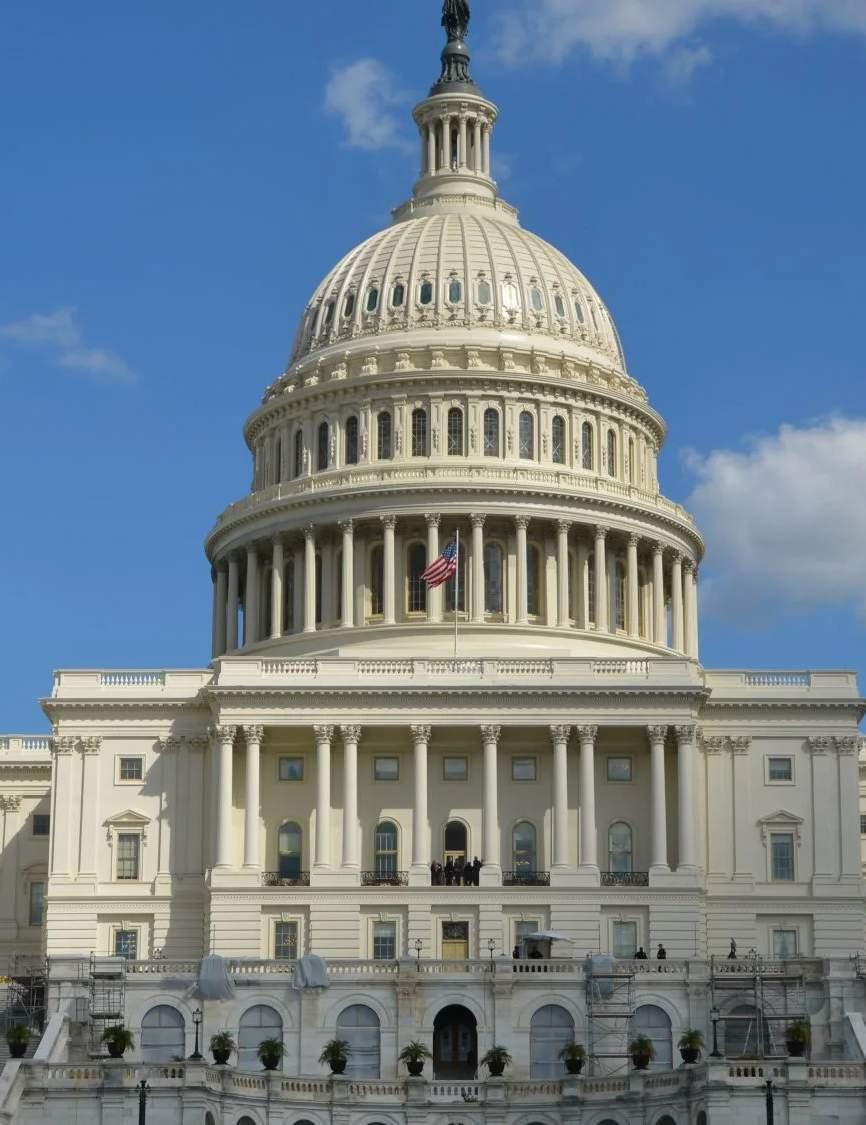
SCHOOL OF PUBLIC POLICY
Georgetown student interns, faculty members and graduate data fellows will have the opportunity to analyze the 2024 primaries and the general election.
DECISION, from A1 public policy major for undergraduates, I was immediately drawn to DDHQ’s connection with the McCourt School and its emphasis on attention to detail and accuracy through data processing,” McDowell wrote to The Hoya. “I am really looking forward to gaining experience in the field before joining the program my junior year.”
Brandon Finnigan, DDHQ’s current director of elections, founded DDHQ in 2012 intending to use algorithms, rather than exit polls or voter interviews, to quickly gather election results and accurately project election outcomes. According to Wilner, the company operated fully remotely prior to its partnership with MPP, often gathering in hotel conference rooms on election nights to analyze results.
Wilner said DDHQ’s new location in the McCourt School would create more chances for public engagement and interaction with Georgetown community members.
“We’ve been almost all-remote for the past decade-plus,” Wilner wrote. “We’re excited about being smack in the midst of the McCourt community and having impromptu, energizing chats with
students and faculty.” Amelia Minkin (GRD ’24), who currently works as a data fellow for DDHQ, said the partnership could lead to more opportunities for Georgetown students who, like her, possess a passion for election data science.
“During my time as a data fellow with DDHQ, I’ve had the chance to build community with others within this niche that share a similar passion for the intersection between data and elections,” Minkin wrote to The Hoya. “Seeing McCourt and DDHQ establish a partnership is so exciting as it expands such an impactful opportunity to fellow Georgetown students.” Besides election monitoring, DDHQ experts will collaborate with university faculty, researchers and Georgetown’s Institute of Politics and Public Service (GU Politics) to create electionwatching programming and contribute to government and public policy class curricula.
Maria Cancian, the dean of the McCourt School, said the partnership will bring students new perspectives on exit polls and election results during a presidential election year.
“Working alongside elections and data experts at Decision Desk HQ (DDHQ) as a part of their 2024 Election Night remote

WBB, from A1
them behind a strong effort by junior forward Brianna Scott. The Hoyas took the lead for the first time in the contest following a 5-0 run halfway through the quarter, launching them ahead 30-29.
Although St. John’s took back the lead temporarily, Georgetown closed the quarter ahead 36-35 following yet another 5-0 run behind a stellar Scott 3-pointer and a nifty Ransom floater.
A highlight-reel reverse layup off of a Scott screen sparked an 8-2 scoring run in the opening of the fourth quarter, and the Hoyas never looked back. Strong scoring efforts by Scott and Bembry helped the team keep pace with the Red Storm,
ultimately ending the comeback attempt and sealing the win.
Scott said the energy of being on the Hoyas’ home turf contributed to the team’s hungry style of play for this contest.
“We owed them one,” Scott told The Hoya. “We dropped one at their place and they’re at our place now and we just had to get them back. That intensity, we come with that every game but it was just especially high for this game ’cause we knew we had to get them back for that.”
Georgetown lost a heartbreaker to St. John’s 57-56 on Jan. 28. Many Hoyas impressed in the contest. Scott led the team in both scoring and rebounding, finishing with a season-high 21 points along with 9 rebounds and 2 blocks. Bembry scored
8 points, grabbing 9 rebounds and dishing out 4 blocks as the team’s glue player. Ransom contributed 6 rebounds, 3 steals and 11 points.
Once again, the No. 13 scoring defense in the country showed up: Georgetown blocked 7 shots, forced 12 turnovers on 6 steals and outrebounded St. John’s 3929. Even though the Hoyas shot 40.7% (22-for-54) on the day, they allowed just 30.6% (15-for-49) shooting by the Red Storm and limited star guard and reigning Big East Sixth-Woman of the Year Unique Drake to just 3-15 shooting from the field.
The Hoyas will take on the Butler Bulldogs (13-13, 5-10 Big East) this Saturday in McDonough Arena at 2 p.m. for their last home game of the season.
HECKLER, from A1
monitoring team will give Georgetown students a unique inside look at the 2024 election,” Cancian wrote to The Hoya.
Wilner said DDHQ wants to involve young people to spread information on the election system, especially as it pursues growth as a newer organization.
“We’re housing a lot of expertise about how democratic elections are conducted and how the outcomes are projected,” Wilner wrote. “Being a young organization — several of our team members are students or recent grads — we want to share these learnings, help students learn through our trove of data, and in the process, not just create more transparency around it all, but draw more public serviceminded people into the work.”
Brian Holland (GRD ’24), a newly hired intern, said he is hoping to contribute to preserving election accountability and democracy through working with DDHQ.
“Part of the reason I wanted to participate was to actually actively contribute to democracy in, at least what feels like to me, a meaningful way,” Holland wrote to The Hoya. “So this is me, trying to help democracy function, by reporting and analyzing election results reporting.”
as Twitter. The post, which received nearly a million views, criticized the students and university administration for permitting the conduct.
“DISGRACE! Students at Georgetown — a Catholic University — have an ‘A** Wednesday’ table on campus with a butt drawn on their foreheads,” Hayek wrote in the post.
“It’s disturbing that these students would mock the sacred tradition of Ash Wednesday — a day of profound significance around the world. Shame on them. And shame on Georgetown for allowing this!!”
A university spokesperson said the university does not endorse the denigration of any faith on campus despite the university’s commitment to free speech.
“As a Catholic and Jesuit university, Georgetown is firmly committed to the Catholic Church’s teachings and values and the celebration of Ash Wednesday on campus,” the spokesperson wrote to The Hoya.
“While Georgetown’s policies give the broadest latitude for the free expression of ideas and opinions, the belittling of any faith tradition on our campus is counter to our values and deeply disappointing.”
“While designated areas on campus are available to members of the University community for tabling or exercising speech without a prior reservation, the presence of a table should not
be considered an endorsement by Georgetown University,” the spokesperson added. Red Square, a university-recognized “public square,” provides students with an area to freely present their views. Political and social tabling, including by organizations the university does not formally recognize like The Heckler, are freely allowed there.
Speech that qualifies as harassment or a legitimate threat to students is not allowed in designated public squares, according to the university’s speech and expression policy.
The Heckler board said their actions were in line with this policy, and the community should consider them as an act of free speech.
“Ass Wednesday is unequivocally an expression of free speech performed within a university-sanctioned free speech zone,” The Heckler board wrote. “We do not feel that we have contributed to any sort of social pressure that Catholics face nationally, especially at a Catholic university.”
Bridgitte Isom (SOH ’24), the president of Catholic Women At Georgetown, a student group on campus, said she found “Ass Wednesday” offensive.
“Ash Wednesday is a serious, holy day for Catholics and Protestants and should be treated with respect,” Isom wrote to The Hoya. “The same goes for any other faith group on campus.”
Cynthia Gudaitis (CAS ’27), who identifies as Christian, said she found “Ass Wednesday” funny but insensitive.
“A joke is a joke, and I think that the intentions weren’t harmful, but I think that it was a little bit insensitive,” Gudaitis told The Hoya. “So maybe The Heckler should just be a little bit more careful next time — know your audience, and instead of tabling that for the entire GU community, keep the joke to a more reserved community.”
Maggie Lober (SFS ’26), a Catholic student, said that The Heckler’s actions overlook the significance of Ash Wednesday for many Catholics.
“It is one of those traditions that has in the past helped to connect Catholics to other community members, who are hoping to see the church for the first time or sort of learn what Lent is about, for example, and I think that making a mockery of that is in poor taste,” Lober told The Hoya. Isom said “Ass Wednesday” contradicts Georgetown’s commitment to promoting interfaith conversations among members of the community.
“Georgetown has a rich tradition of fostering interreligious dialogue and understanding, working against division and prejudice,” Isom wrote. “These ‘jokes’ are counterproductive to that effort by normalizing religious mockery.”
GU HOYAS The Hoyas women’s basketball team edged out an unexpected victory over the St. John’s Red Storm behind 8 points from graduate forward Mya Bembry. MCCOURTThe Middle East Studies Association of North America (MESA), a nonprofit organization that fosters inclusive dialogue on Middle Eastern studies, announced its relocation to Georgetown University on Feb. 21.
The School of Foreign Service Center for Contemporary Arab Studies (CCAS) will house MESA, which focuses on building scholarly understanding of Iran, Turkey, Afghanistan, Israel, Pakistan and other Arab countries’ cultures. MESA leaders said the new location will foster greater opportunities for students to engage with experts on the Middle East through events and research opportunities.
CCAS Director Fida Adely said MESA’s relocation will boost the university’s Middle Eastern studies program for both undergraduates and graduate students.
“There are going to be many opportunities for intellectual exchange and for us to co-host and sponsor events,” Adely told The Hoya. “MESA has also got a very strong undergraduate education committee that really tries to support undergrads interested in the Middle East.” Adely said MESA’s resources and experts will augment Georgetown’s reputation as a center for academic study of the Middle East.
“It’s the premier professional association for anyone who does Middle East studies, and Georgetown is known as the university that has the most going on in terms of Middle East studies,” Adely said. “Georgetown has a lot of strength when it comes to the
Middle East and Islam.”
MESA’s headquarters are typically located at the nation’s best institution for Middle East studies, according to the nonprofit’s executive director, Jeffrey Reger (SFS ’10, GRD ’14, ’18). Prior to its move to Georgetown, MESA had been based at George Washington University since 2020, Adely said.
Reger said Washington, D.C., is a strong location for MESA thanks to its concentration of experts and graduates in Middle East studies, including from Georgetown’s Master of Arts in Arab Studies (MAAS) program.
“Georgetown’s faculty and students are very well represented in our membership, and MESA frequently organizes meetings in Washington, DC for our academic conference,” Reger wrote. “In addition, MESA is expanding its outreach to professionals in Middle East Studies outside of academia, for whom DC is the largest such grouping in the US, and MAAS graduates from CCAS are a key constituency.”
Reger said MESA will provide CCAS graduate students with access to an abundance of new resources including direct intellectual dialogue on-site with MESA staff.
“We have found that there are mutually beneficial opportunities to being in a central, academic setting — specifically through collaboration with colleagues, whether students or professors, on a regular basis. Georgetown’s faculty and students are very well represented in our membership, and MESA frequently organizes meetings in Washington, DC for our academic conference,” Reger wrote.
Graduate student Asa Breuss-Burgess (GRD ‘25), who is doing a Master’s in Middle East studies within the Arab studies program, said MESA will help him achieve his goal of discussing critical Middle East issues in a productive environment.
“It’s definitely good to be opening up conversations on what are very critical issues and approaching them in a way that can benefit all stakeholders,” Breuss-Burgess told The Hoya Reger said that MESA’s Annual Meeting, a conference in which members share research and connect through events, is a key component of getting involved in MESA, especially for those seeking a career centered on Middle East studies.
“Interested graduate students should definitely consider joining us at our Annual Meeting, which is also known as the MESA conference, which is held each fall, and regularly in Washington DC. Again, the breadth of Middle East studies represented at our Annual Meeting is unique, and should not be missed, especially if one is considering a career in Middle East studies,” Reger wrote to The Hoya Adely said the potential for Georgetown professors and MESA experts to engage in academic discourse will widen with MESA’s move.
“Some of the possibilities we see in that — besides the fact that we think this is important just in terms of our stature, as a place that does Middle East studies and the importance of this institution and our academic lives — is that we have this potential to do events in-person events together,” Adely said.
Evan Ecklund Copy Chief
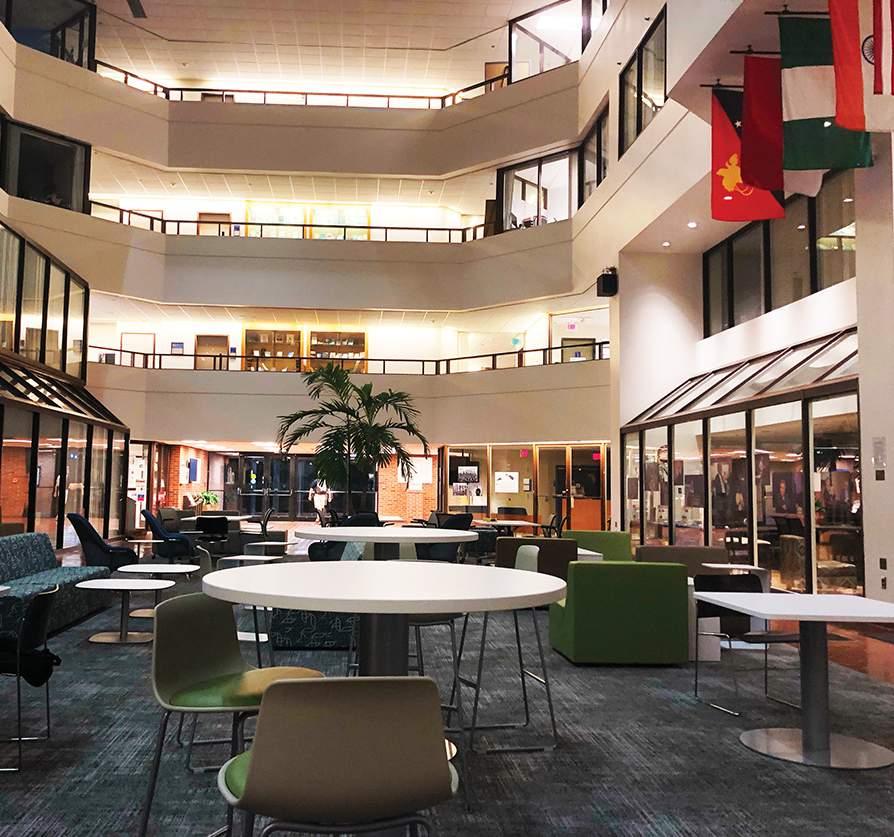
MAGGIE FOUBERG/THE HOYA
The relocation of the Middle East Studies Association of North America (MESA) to the School of Foreign Service Center for Contemporary Arab Studies (CCAS) will provide students with new opportunities for cultural exchange, according to MESA leaders.
The author of a book examining the evolving relationship between the queer community and Orthodox Judaism shared insight about her ethnographic research and writing process at a Feb. 20 event.
Orit Avishai, a professor of sociology and women’s, gender and sexuality studies at Fordham University, discussed her March 2023 book “Queer Judaism: LGBT Activism and the Remaking of Jewish Orthodoxy in Israel” and her experiences with ethnographic research. The Center for Jewish Civilization (CJC), an interdisciplinary unit within the School of Foreign Service (SFS) that focuses on analyzing Judaism as both a religion and civilization, hosted the event.
Avishai’s book explores the increasing visibility of the queer community within Orthodox Judaism in Israel and how this phenomenon has contributed to the rise of a productive activist movement. The book largely centers on recounting stories from openly queer people.
Avishai said that a common theme she heard during her interviews was a desire to create space for queer people to exist and express their identities.
“There was a rhetoric of political moderation: ‘We’re not here to rock the boat, we’re not here to make some huge statement, we’re not here to blow up the system, we just want,’ as one activist said, ‘A room of our own in the Jewish home,’” Avishai said at the event.
Jessica Roda, an assistant professor of Jewish civilization at Georgetown University who researches the Orthodox Jewish community and moderated the event, said that discussions of queerness in religious communities, like those Avishai’s book explores, are relevant globally.
“Some people may resist or refuse this type of dialogue,” Roda said in her introduction. “In this context, engaging in dialogues that transcend the immediate conflict might be perceived as legitimizing or accepting violence. Instead, I see it as an opportunity to unsettle our complacency and challenge our perspectives.”
Avishai said that her position as an ethnographer, a community-based researcher whose work synthesizes qualitative and quantitative approaches, shaped how she researched her book, which was conducted before the Oct. 7 attacks in southern Israel and the ensuing invasion of the Gaza Strip.
Avishai said she aimed to be transparent in her research that she is someone who does not identify with the queer Orthodox community she was researching — especially to her interviewees.
“I was very upfront. I was born and raised in Israel, so a native Hebrew speaker, but as far from orthodoxy as you could be, and I do not identify as queer,” Avishai said. “People did not care, and for many, especially the activists, they thought it was actually an advantage to have a professor coming from the US to write about their movement.”
Roda said that she hoped the event would cause people to reassess their preexisting opinions on the relationship between queerness and religion.
“It’s very hard to have a dialogue like this because there are radical positions on so many different sides,” Roda said in an interview with The Hoya . “Work like this puts us in uncomfortable positions on so many different issues. So that’s the idea, to be uncomfortable, to be confused and maybe to rethink a lot of assumptions that people will have on different issues related to sexuality.”
Avishai said that, in compiling her research, she had to both theorize and tell stories because she has noticed through her experience as a professor that queer and sexuality theory classes often lack a study of religion.
“There’s this sort of ‘problem of religion,’ right? I came to the field with an interest in ‘What does it mean to be queer? How do you make change?” Avishai said.
“The fact that this was an LGBTQ movement for social change didn’t quite follow the script for other secular movements.”
Avishai said that the queer community in Israel is an important topic because it presents two groups that people tend to see as opposed. She said ethnography can be particularly powerful because it is rooted in the stories of individual people.
“This is really the power of ethnography, right?” Avishai said. “When you start from the ground up, then you’re constantly grounded in the stories people tell. Yes, obviously there’s framing and there’s an interpretation and a critical view and it is our responsibility to note those.”
“But the research comes together around the stories that people themselves tell, and people are complicated, right? Lives are complicated,” Avishai added. “People blow up binaries and categories all the time.”
The Washington, D.C. Board of Elections issued a petition filed by residents of the largest ward in D.C. to recall City Councilmember Charles Allen (D-Ward 6) due to his legislative record on public safety on Feb. 13.
April Brown and Jennifer Squires, two of Allen’s constituents in Ward 6, began “Recall Charles Allen,” the official campaign in support of Allen’s removal from office, which puts him at risk of being the first city councilmember to be recalled from office. As of Feb. 15, the campaign claimed to have raised over $85,000 dollars and organized more than 500 volunteers.
Alongside other D.C. residents, Brown, a real estate agent, and Squires, a consultant, partially blame Councilmember Allen for an uptick in crime, with the District experiencing a 35% increase in homicides in 2023.
Squires, who filed the petition Dec. 13, said that Allen must be recalled because he has not lived up to his duty as a city councilmember to protect public safety.
“The top priority for any elected official is to keep the public safe,” Squires wrote in the official recall petition. “On this score, Charles Allen has failed miserably.”
As the former chairman of the Judiciary and Public Safety Committee, a committee within the council focused on issues relating to crime and public safety, Councilmember Allen has supported multiple controversial changes to the criminal justice system during his time in office.
The Recall Charles Allen campaign cited cutting the Metropolitan Police Department’s (MPD) budget by $15 million in 2020 and expanding the Youth Rehabilitation Act,
which allows early prison release for young offenders who committed violent crimes, as two of Allen’s policies that disregarded public safety. According to the National Institute of Corrections, incarceration does not decrease levels of violent crime. In order to successfully recall Councilmember Allen, “Recall Charles Allen” will have to collect just over 6,000 signatures from Ward 6 residents by Aug. 12, 180 days after the petition was officially filed. However, many Ward 6 residents are not supportive of the effort.
Rosina Memolo, an elementary and high school art teacher in Ward 6, started “No Recall in Ward 6” to fight back against the “Recall Charles Allen” agenda. Memolo said that this recall effort will only make matters worse in D.C.
“Forcing all DC taxpayers to fund a costly recall election won’t improve the quality of life in DC,” Memolo wrote to The Hoya. “It won’t stop crime.”
Due to the large front of opposition Allen faces, he has begun to staff his own anti-recall campaign. Councilmember Allen enlisted Tommy Wells, Allen’s predecessor as Ward 6’s councilmember, to spearhead his personal campaign against the recall.
As the leader of Allen’s anti-recall campaign, Wells has countered claims that Councilmember Allen disregarded the District’s public safety. Wells told The Hoya in an interview that Councilmember Allen focused on addressing the origins of crime, rather than putting more people in jail.
“Charles really led the way in trying to get to the root causes of crime,” Wells told The Hoya. “Charles spent a lot of time thinking, ‘Well, how do we get smarter about this if locking people up is not providing the answers?’”
Former MPD Chief Robert Contee has stated
that Allen’s public safety policy negatively affected crime in the District. Contee cited the police hiring freeze that resulted from Allen’s MPD budget cuts in 2020 as a major public safety concern facing D.C.
“We went a year without hiring police officers,” Contee told The Politics Hour podcast. “It will take years for us to recover from the decisions that were made.”
Since Ward 6 encompasses the Capitol Hill neighborhood, many national political players have joined the effort to recall Councilmember Allen. Many of those donating to Recall Charles Allen are prominent Republican staffers, including Jeff Bishop, chief of staff to Rep. Marc Molinaro (R-N.Y.), Ben Falkowski, chief of staff to Rep. Rudy Yakym (R-Ind.), and Yvette Wissmann, legislative director for Rep. Mimi Walters (R-Calif.).
Councilmember Allen faces significant opposition from members of his own party as well.
Tonya Fulkerson, the head of finances for Recall Charles Allen, has worked as a leader in Democratic fundraising in the District for years. Despite her position as a strong advocate for the Democratic Party, Fulkerson has stated that Councilmember Allen has taken criminal justice reform too far.
“He pushes these policies that are extreme far left,” Fulkerson told Politico. “He listens to these extreme advocacy groups over his own voters in his own ward.”
Wells claimed that Ward 6 residents in favor of Allen’s recall are using him as a scapegoat for their concerns over crime, rather than providing evidence that he played a role in allowing increased crime in the D.C. “Everyone, including myself, is frustrated, angry and upset about crime spiking in our city,” Wells said. “Scapegoating one person does not make any sense, but it may make some people feel better.”
Researchers and activists discussed the impact of Chinese Communist Party (CCP) repression on Chinese students’ free expression on U.S. university campuses at a Feb. 21 panel at Georgetown University.
Panelists discussed how the CCP has sought to prevent Chinese students in the United States from dissenting and the problems higher education institutions face in combating this repression. Georgetown’s Asian American Student Association, Asian studies program and Georgetown University College Democrats hosted the event.
The discussion began with Zhang Jinrui (LAW ’24), a pro-democracy student organizer, sharing his personal experience with on-campus harassment and repression.
Zhang participated in the White Paper movement, a series of protests against the Chinese government’s “zero-COVID” policies and censorship, last year, handing out flyers opposing CCP policies on Georgetown’s campus. Zhang said a member of the Georgetown branch of the Chinese Students and Scholars Association, an official organization of Chinese students studying outside of the People’s Republic of China (PRC), verbally assaulted and recorded him.
“They were on a call with some-
one in China, they turned the phone around to show them my face, saying, ‘Take a picture, show it to CCP police,’” Zhang said at the event.
Zhang said the Chinese police interrogated his family in China months after this harassment. He said the situation is part of a systematic wave of transnational repression targeted at Chinese overseas students in Washington, D.C.
“Immediately nothing really happened after I first spoke out, and that was around the end of 2022, nobody came to my family, they were living life as normal,” Zhang said. “That was until 2023, when there was a whole wave of harassment directed against Chinese students who were living in the D.C. area. They somehow got the contact information of a lot of these Chinese students and they began harassing them one by one.”
Zhou Fengsuo, a key student organizer in the 1989 Tiananmen Square protests, student-led demonstrations in Beijing that called for democracy and free speech, and current director of Human Rights in China, an organization supporting civil society actors by advancing and protecting human rights in the PRC, said overseas students like Zhang are essential in encouraging students living in China to dissent against authoritarian CCP policies.
“This message of ending “zero-COVID,” freedom not slavery, elec-
tions not dictatorship, was transmitted back to China and echoed within China,” Zhou said at the event. “It was mainly the overseas Chinese student organizers who were carrying out the message.”
Zhou said that many pro-democracy Chinese students in the U.S. have to live underground, hiding their true beliefs and identities, due to the threat of repression from the Chinese government.
Zhou said higher education institutions’ failure to appropriately teach about the history of censorship in China facilitates this repression.
“U.S. colleges have a lot to do with it. We experience this constantly. For example, there are so many Asian studies departments, but when was the last time we talked about Tiananmen?” Zhou said at the event.
“We have institutionalized the censorship and the fear of communist China in this country and that’s the reality. We have to change it.”
Sarah McLaughlin, a senior scholar of global expression at the Foundation for Individual Rights and Expression, a free speech nonprofit that has invited controversy for its ties to conservative groups, said that it is often difficult for universities to effectively address transnational repression as they sometimes have partnerships with satellite campuses in the countries enacting the repression.
“It’s very difficult to say that, yes, we recognize our students from China are experiencing harassment and transnational repression, and also we have a university there and let’s not talk about it,” McLaughlin said. “It’s very difficult to explain why your business partner may be harassing your students.”
Wang Yaqiu, the free speech nonprofit Freedom House’s research director for China, Taiwan and Hong Kong, said universities must prioritize academic freedom over potential profits.
“University higher-ups and leadership, including their president, should come out and say that this student is being targeted for transnational repression, being harassed by another student or his family is being harassed. We are paying attention to this. We do not tolerate it,” Wang said. McLaughlin said universities must act to prevent foreign governments in countries aside from China, including India and Saudi Arabia, from using similar mechanisms to the CCP to silence overseas students.
“When you create those systems, it’s not going to be just one country that uses them,” McLaughlin said. “I think we need to start imagining that a lot more countries are going to be using these tactics and if we don’t stop it now, we’re going to be creating this turn-key system of censorship where any country can just turn the key and get what it wants.”
Ruth Abramovitz
Special to The Hoya
Two climate protesters were arrested after pouring red dust on themselves and the encasement holding the original copy of the U.S. Constitution in the National Archives’ rotunda Feb. 14.
The protesters belong to Declare Emergency, a climate activist organization that practices public, nonviolent protest with the goal of prompting President Joe Biden to declare a climate emergency. According to a press release from the National Archives, security immediately evacuated the rotunda of the Archives following the incident and Washington, D.C. Metropolitan Police Department (MPD) officers arrested the two protestors.
Donald Zepeda, one of the protestors, said that declaring a climate emergency would allow President Biden to take direct, expansive executive action to address the climate crisis and create a sense of urgency around climate change.
“Declaring a climate emergency, if the president does that, unlocks abilities to advance a lot more clean energy, get more of
in, and
back on
and
fuel,” Zepeda told The Hoya. “Having the declaration also conveys to the public how bad it is.”
In a video of the demonstration posted to X, formerly known as Twitter, by documentarian Ford Fischer, Kroegeor Contrapip — the other of the two protesters — said he believes climate action is inherently linked to the rights the Con-
stitution protects. “This country is founded on the conditions that all men are created equally, endowed with the unalienable rights of life, liberty and the pursuit of happiness,” Contrapip said in the video. “We’re calling for all people to have these rights, not just wealthy white men. We all deserve clean air, water, food and a livable climate.”
Although the statement confirmed that the Constitution was unharmed, the rotunda remained closed for cleaning services and further evaluation of the damage Feb. 15 and 16.
Colleen Shogan, the archivist of the United States, condemned the demonstration and called for the protesters to receive the harshest legal penalty available.
“The National Archives Rotunda is the sanctuary for our nation’s founding documents,” Shogan wrote in a press release. “They are here for all Americans to view and understand the principles of our nation. We take such vandalism very seriously and we will insist that the perpetrators be prosecuted to the fullest extent of the law.”
Declare Emergency has previously led nonviolent protests in the Washington, D.C. area. Last April, the group blocked access to the George Washington Memorial Parkway and smeared paint on the glass case of Little Dancer, an Edgar Degas sculpture, at the National Gallery of Art.
Tim Martin, a mobilization coordinator at Declare Emergency, said that this type of provocative
protest — inspired by the European climate organization A22, which has launched similar protests at London’s National Gallery, London’s Madame Tussauds and Museum Barberini in Potsdam, Germany — aims to forcefully seize the attention of leaders across both political parties.
Martin said that in addition to creating shock, he hopes that these demonstrations also yield real conversations around addressing climate change.
“What we learned from the Little Dancer action in April is that the news goes around the world,” Martin told The Hoya. “It’s as provocative as all the other A22 actions in Europe, except nobody’s talking about why we’re doing it. They give it a little bit of lip service.”
Despite backlash from the public and the authorities, Zepeda said Declare Emergency hopes to ramp up the scale and impact of their demonstrations as the climate crisis worsens.
Zepeda said that the more disruptive they can make their protests, the more effective they believe they will be in creating urgency around the changing climate.
“For a while now, I’ve kind of known that this sort of thing needs to be scaled up if we want to succeed at the scale and pace that we need to to address the climate emergency. There’s too much at risk with food shortages, droughts,” Zepeda said. “We need to act like we’re terrified, or else no one will believe that this is really as bad as it is.”
Maren Fagan
Academic Desk Editor
A Georgetown University English professor won the 2023 Security Studies Network (SSN) Book Prize, an award that recognizes the top scholarship of a book about security studies, the English department announced Feb. 15.
Brian Hochman, American Studies program director, received the award for his 2022 book “The Listeners: A History of Wiretapping in the United States.” The book examines how communication companies and the U.S. government surveilled citizens and customers, beginning as early as tracking telegraphs during the Civil War and continuing to modern electronic monitoring. Hochman said he discovered the topic of wiretapping in the United States by accident when reading about the topic in a 19th-century newspaper.
“Eight years later –– after reading tens of thousands of pages of government documents, combing through legal cases and archival records and conducting interviews with privacy advocates and former surveillance technicians –– I’d written a book. But there is still so much more work to be done,” Hochman wrote to The Hoya
The SSN Prize awards the scholar of the best written study of a surveillance topic from the preceding year. Hochman’s book also won awards for being one of Publisher Weekly’s Best Nonfiction Books of 2022 and one of CrimeRead’s Best Critical/ Nonfiction Biography Books of 2022. Daniel Shore, the chair of the
English department, said Hochman’s colleagues are proud of the recognition his book has received since its publication.
“It is a testament to how the best interdisciplinary work in our field can illuminate the conditions in which we live and how we got ourselves into our current predicaments,” Shore wrote to The Hoya. “The humanities needs just this sort of recognition of the essential work it does in helping to understand our society and our world.”
According to Shore, Hochman received support from the English department in research and production, as well as from external fellowships and grants, including from the John W. Kluge Center at the Library of Congress, a center that connects scholars researching the top issues of the 21st century. Shore said, above all, that the book’s success ultimately represents Hochman’s dedication beyond the support from Georgetown colleagues.
“Georgetown has supported the research that Prof. Hochman does through providing the time and money needed to do serious, extended reading in libraries and archives,” Shore wrote. “All of that matters, even if the success of the book finally came down to the immense labor and talent that Hochman invested in it.”
Fiona Richards (SFS ’25), a student in Hochman’s “American Literature” class, said that the class, while not directly related to his research, represents the broad context of his work.
“There’s so many different disciplines that he’s pulling together in his work and also in his classes,” Richards told The Hoya. “It gets really clear when he teaches because he has this wealth of knowledge that he’s sharing with us while helping us hone that skill of making connections between literature and sort of lived social realities.”
Richards said Hochman’s expertise in international relations (IR), security studies and technology, along with his work at Georgetown, represent the scholarship that can happen within the different fields of study.
“I think this award is a great recognition of one of those areas that Professor Hochman is involved in,” Richards said. “I think that part of what makes him so knowledgeable in IR and in security studies is his backing through history, in literature and in American studies.”
Hochman said the research taught him that Americans tend to care less about electronic privacy now than in the past.
“For the better part of a century — from the late 1860s to the late 1960s — Americans of all political stripes believed that wiretapping was both unconstitutional and unethical,” Hochman wrote. “The strength of that conviction prevented the U.S. government from establishing the authority to conduct electronic surveillance.”
“Today we live in an era of resignation. I think we’d do well to recover the urgency of an earlier historical moment,” Hochman added.

Hoya basketball fans left Capital One Arena disappointed once again as the Georgetown University men’s basketball team dropped its 10th straight in a homestand against the Villanova Wildcats, 70-54.
Georgetown (8-17, 1-13 Big East) came out of the gate playing intense lockdown defense, holding Villanova (1411, 7-7 Big East) scoreless for the first three and a half minutes of the game, while also forcing two shot clock violations. At the same time, the Hoyas showed signs of a promising offensive performance, holding an 8-3 advantage over the Wildcats six minutes into the contest.
Despite the temporary defensive chokehold the Hoyas imposed on the Wildcats, Villanova bounced back, breaking down the Georgetown defense by forcing turnovers and taking advantage of fast break opportunities, resulting in a 15-12 lead with just under nine minutes remaining in the half.
This was quickly followed up by a 3-pointer from the Hoyas to bring the score back to a tie.
Unfortunately for Georgetown, this was the last time they would see a level score, as the Wildcats unleashed an 11-2 run, including two 3-pointers from guard Brendan Hausen, to take a commanding 26-17 lead over the Hoyas.
To maintain the same momentum seen in the first three minutes of the game, Head Coach Ed Cooley pointed toward the need for a stronger defensive mentality across the team.
“To me, defense is a want, a will and an attitude — any great team in college, the best teams, they’re not always the most talented teams but they have a fight and desire to defend,” Cooley told The Hoya in a postgame press conference.
“That’s a prideful thing and that’s something we hope to instill as we continue to build our program at Georgetown.”
Despite showing some defensive capability, scoring has been a crucial shortcoming for the Hoyas throughout the season, and their struggles were on full display in the first half.
Georgetown, which entered the game as the Big East’s second-lowest scoring team, scored just 19 points compared
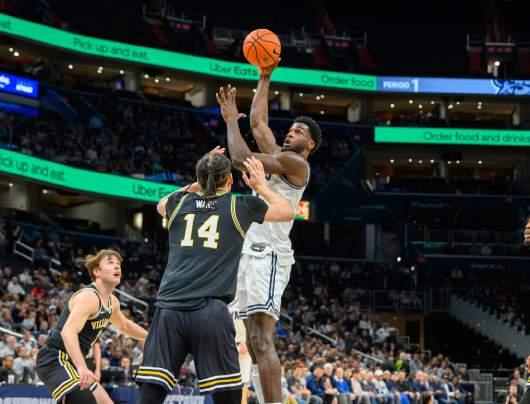
to Villanova’s 28, the worstscoring half of the season for the Hoyas. Georgetown shot just 25.8% from the field, including a frightening 15.4% (2-for-13) from 3-point range.
Nonetheless, the Hoyas came out of the halftime break on fire, scoring two consecutive 3-pointers, behind first-year guard Rowan Brumbaugh and junior guard Dontrez Styles, to cut the Wildcats’ lead down to three. The Wildcats quickly recovered, however, throwing down a dunk and downing a 3-pointer to firmly regain control of the pace and extend their lead to 11.
It was beginning to seem that all was lost for the Hoyas, but the team managed to rally back and get within two possessions of the lead as they cut an 11-point Wildcat lead to 6 after scoring sequences featuring sophomore guard Jayden Epps, senior guard Jay Heath, Brumbaugh and Styles.
Unfortunately, the Wildcats continued to shoot extremely efficiently — 59.3% (16-for27) from the field for the half, including 43% (6-for-14) from beyond the arc — outscoring the Hoyas 42-35 in the second half and extinguishing all hopes of a comeback.
Nevertheless, the Hoyas dramatically improved their shooting efficiency in the second half, shooting 43.3% from the field and a subpar, but improved 30% from 3-point range. This almost doubled their percentages from the first half.
Individual standouts in the
game included Brumbaugh, who supplied a team-high 14 points and 5 assists off the bench on 60% shooting, and senior forward Supreme Cook, who had 8 points and 11 rebounds, 5 of which came on the offensive end. Georgetown also showed flashes of a cohesive defense throughout the game, improving upon previous blowouts to then-No. 9 Marquette (19-6, 10-4 Big East) and No. 1 UConn (24-2, 14-1 Big East). Despite ultimately losing by 16, Cooley said the team had one of its best defensive showings to date.
“I thought we played harder today,” Cooley said. “I thought we were a lot more detailed in our defensive approach. I thought this was the most connected we’ve been defensively.”
Cooley also commended Hoya basketball fans for continuing to show out for the team despite their recent struggles, as the home crowd of 9,406 was among the largest this season. New Washington Commanders General Manager Adam Peters and Head Coach Dan Quinn were also in the building.
“I’m grateful for our crowd. I’m grateful for our students. I just need them to hang in there with us as we continue to fight and claw,” Cooley said.
The Hoyas will look to snap their 10-game losing streak as they gear up to face the St. John’s Red Storm (14-12, 6-9 Big East) at home Feb. 21 at 7 p.m.

out of town — I can’t watch the game at all. Obviously, it’s the Astros’ fault. Everything is.
Because of this — and in (dis)honor of Astros’ infielder José Altuve’s recent contract extension and the induction of a new class of Hall of Famers — I’m going to tell you exactly why none of the 2017 Astros deserve to be in the Hall of Fame.
There is a reason I hate the Astros as much as I do. It’s not just that my eyes hurt when I look at the color orange.
In 2017, the Astros engaged in an illegal scheme to steal opposing catchers’ signs. They implanted a camera in center field, zoomed in on the catcher and communicated the signs to
batters by banging on garbage cans. And then, the Astros won the 2017 World Series. I remember when the news of the cheating scandal broke. It was 2019, and I was a very angry 15-year-old. I awaited a swift and just response from Major League Baseball (MLB), but it never came.
The league fined the Astros $5 million, suspended both their general manager and manager for one year and denied them first- and second-round draft picks for two years. That is quite a discounted price for a World Series trophy.
Unsurprisingly, fans called for MLB Commissioner Rob Manfred to strip the Astros of their nowtainted World Series title. He practically laughed in our faces. “The idea of an asterisk or asking for a piece of metal back seems like a futile act.”
But Manfred is blind to the fact that it’s not just about the “piece of metal” itself. It’s about the history and integrity of a game that is fundamentally intertwined with American society. The Baseball Hall of Fame has always closed its doors to cheaters. Barry Bonds, whose statistics are laughably incredible, fell short of election because of his steroid use. Pete Rose, who amassed more hits than anyone else in MLB history, is ineligible from appearing on the Hall of Fame ballot because he placed bets on baseball games. There are countless others in a similar position.
At its first-ever Major League Baseball (MLB) Desert Invitational in Phoenix, Ariz., the Georgetown University baseball team went 0-3 in its opening weekend, losing 5-2 to Grand Canyon University on Friday, Feb. 16, 12-3 to University of California Berkeley on Saturday, Feb. 17 and 7-6 to Kansas State University on Sunday, Feb. 18.
The MLB Desert Invitational is an annual eight-team tournament showcasing some of the top collegiate baseball programs in the nation. Georgetown was one of six schools participating for the first time in the event, which is being held for the fifth time.
When playing the GCU Antelopes (4-0) on Friday, the Hoyas (1-3) spent 6 innings facing one of the top pitchers in college baseball, Daniel Avitia. The junior right-handed pitcher, who was named an All-American player as a first-year and ended his sophomore season with 192 career strikeouts, tallied 5 strikeouts and allowed only 1 earned run.
Nonetheless, the Hoyas put up a good fight. Georgetown’s firstyear left-handed pitcher Marcello Mastroianni made his college baseball debut against GCU, finishing with 5 strikeouts and 1 earned run in 4 and 2/3 innings.
“To have that be my first game is something that I’m very, very grateful for,” Mastroianni told The Hoya. “I felt good, I was confident in myself and I felt that my team felt confident in me.”
“The main thing is just remembering to try not to be too perfect,” Mastroianni added.
In the first inning against GCU, Georgetown senior right fielder Jake Hyde doubled to center,
allowing graduate outfielder Derek Smith to score and giving the team an early 1-0 lead. This was not the only early lead for the Hoyas over the weekend, as they also entered the top of the second inning against Berkeley (2-1) up 1-0.
However, the Hoyas did not score again until the ninth inning against GCU, when senior first baseman Christian Ficca’s double brought in senior shortstop Michael Eze to narrow GCU’s lead to 5-2.
Head Coach Edwin Thompson said the team’s inability to close the run gap in prime opportunities ultimately cost them valuable wins over the weekend.
“There are no excuses, and we need to find a way to get more runs,” Thompson told Georgetown Athletics.
“We didn’t score with runners in scoring position,” he added in an interview with The Hoya. “I don’t think it’s a weakness, it’s just baseball.”
Yet, Thompson said he remains unconcerned about scoring woes affecting the rest of their season.
“We know we have a good team,” he explained. “We take areas that we need to work on and we work at those. We’ll continue to improve and get better.”
On Saturday, the UC Berkeley Golden Bears gave the Hoyas another run for their money. Despite Georgetown’s early lead, the Golden Bears rallied with 4 runs in the fourth inning and 5 additional runs in the fifth.
“We had chances early in the game to punch some guys out and unfortunately, we didn’t do it and that is something we have to get better at and will get better at,” Thompson told Georgetown Athletics.
Coming off the harsh loss against UC Berkeley, the Hoyas concluded the tournament with a nail-biting 7-6 loss against KSU (2-2). Down
by 3 runs entering the top of the ninth, Georgetown scored 2 runs off a clutch home run by graduate second baseman Josh Rolling, needing only one more to see the game continue into the bottom of the ninth. Unfortunately, the Hoyas were unable to bring one more run home, resulting in the tough loss.
Sunday’s notable pitching performances included 3 strikeouts by junior Andrew Williams and 4 strikeouts by senior Everett Catlett. In addition, two of Georgetown’s graduate students dominated offensively, with third baseman Joe Hollerbach hitting his first Hoya home run and going 1-for-2 with a walk and a hit by pitch, and Rolling going 2-for-3 with 3 RBIs, a 2-run home run and a walk.
Thompson said the combination proved effective and that he was glad to see the graduate students’ strong performances.
“It’s always good to get the first one,” Thompson told The Hoya. “Once you get one, it’s easier to get two. In the time that they did it, we needed them to do it. Really happy, really proud of them.”
Thompson remained optimistic about the team’s outlook this season, especially as Georgetown begins home play at Capital One Park in Tysons, Va. in March.
“The Hoyas’ baseball continues to get better as the year goes on. We have easy metro access to the field. As the year goes, come out and watch,” Thompson said.
Georgetown finished off a comeback against Navy (2-2), playing well and winning 5-3 on Feb. 21. They will look to add another tally to the win column in their next away game against Virginia Military Institute (23) on Feb. 23 in Lexington, Va.
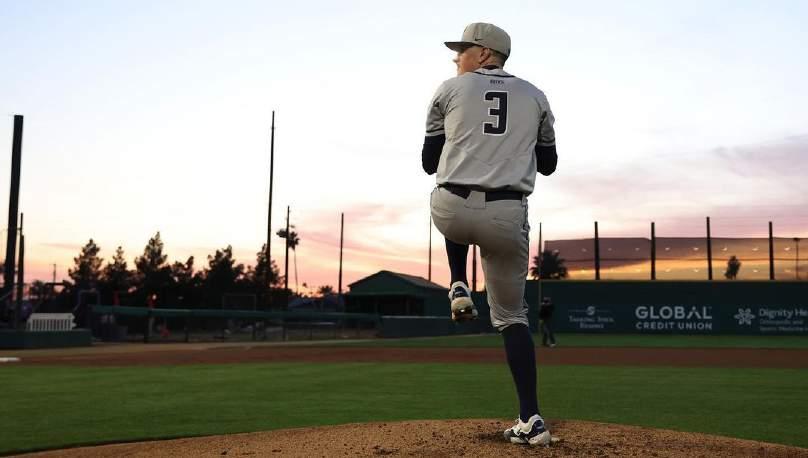
Somehow, though, former Astro Carlos Beltrán — who was fired from his managing job because of his involvement in orchestrating the Astros’ scheme — garnered 57.1% of the Hall of Fame vote in his most recent appearance on the ballot. Although this is far short of the required 75%, Beltrán has several more opportunities to earn induction, and history suggests that he will likely meet the threshold.
Beltrán is not the only potential candidate from the cursed 2017 Astros. Starting pitcher Justin Verlander and the recentlyextended Altuve both have Hall of Fame-worthy resumes.
We cannot look past the asterisk on all of their careers.
It is unacceptable to bar legends Bonds and Rose from the Hall of Fame because of ethical qualms, and then turn around and welcome key members of a cheating team.
Making the Hall of Fame is baseball’s highest honor. It is a place not just for those who are good at baseball, but for those who deserve to be remembered for it.
The 2017 Astros do not.
In dismissing fans’ outrage over the cheating scandal, Commissioner Manfred brushed aside the possibility of holding the Astros accountable for their sins. Now, the burden is on the Hall of Fame voters to reject the Astros — and to reject hypocrisy.
Eilat Herman is a sophomore in the College of Arts and Sciences.
managed to score another goal at the end of the first quarter, making the score 4-2.
Despite keeping it close throughout the first quarter of their home opener against Rutgers (3-0) on Feb. 17, the Georgetown University women’s lacrosse team (2-1) went scoreless in the second quarter, allowing the Scarlet Knights to run away with the game in a 13-6 win. This marked the Hoyas’ first loss of the season.
Coming off a big 13-5 road win against Towson (1-1) on Feb. 14, Georgetown was hoping to open their season on a three-game win streak against Rutgers. On a chilly Saturday afternoon at Cooper Field, the Scarlet Knights kicked off the scoring with a goal during the opening minute of the game.
However, junior attacker Emma Gebhardt responded with less than five minutes remaining in the first quarter to tie the score 1-1.
Reflecting on the game and the team’s performance, Gebhardt said she had mixed feelings. “There were some things that went well, but also things we need to work on,” Gebhardt told The Hoya. She added, “We always take it one game at a time.”
Following a 3-goal run by the Scarlet Knights, Gebhardt
However, the visitors’ offense proved too strong for the Hoyas in the second quarter, who had no answers on either end of the field. Holding Georgetown scoreless, Rutgers added 5 additional goals in the period. Heading into halftime, the Hoyas were on the wrong end of a 9-2 scoreline.
Georgetown finally found some momentum in the third quarter, as sophomore attacker Gracie Driggs added a point for the Hoyas. Rutgers, however, was unfazed, responding with 3 goals of their own to take an insurmountable 9-goal lead, 12-3, heading into the final quarter.
Georgetown won the fourth quarter scoring battle 3-1, but it proved too little, too late. Rutgers ran out the clock the rest of the game to claim a comfortable 13-6 victory over the Hoyas.
After the game, junior midfielder Maley Starr said the team’s preparation for the home opener fell short of expectations.
“There was a lack of discipline throughout the game. This game was disappointing,” Starr told The Hoya. “We were coming off a big win over Towson, and I don’t think we prepared ourselves properly for the opponent.” Rutgers heavily outshot
Georgetown 34-to-21, including a 25-to-17 disparity for shots on goal. The Hoyas also conceded 19 turnovers in the game, three more than their opponents.
However, Starr offered high praise for junior goalkeeper Leah Warehime, who finished the game with 12 saves for a .480 save percentage to keep Georgetown competitive despite the major shot disparity.
“Our goalie, Leah, had our back throughout the game. However, we weren’t performing well on many other areas of the field,” Starr said. Looking back at her performance, Warehime emphasized the value of fundamentals.
“There are definitely things to work on in all areas of the field,” Warehime told The Hoya. “We need to focus on valuing the ball and executing the fundamentals.”
Despite the loss, Starr was optimistic that the team could learn from its mistakes as the Hoyas look forward to their first conference game against Villanova (2-1) on March 23.
“Luckily a loss like this happened early in the season and we will be able to learn moving forward,” Starr said.
The Hoyas will look to get back in the win column as they take on Harvard (1-0) on Feb. 23 at Cooper Field.

LONERGAN, from A12
The sport operates within two organizations, the World Darts Federation (WDF) and the British Darts Organisation (BDO), which set up tournaments around the world, akin to the Association of Tennis Professionals (ATP) and Women’s Tennis Association (WTA) circuits for tennis. Despite its highly regionalized popularity, it is growing rapidly, with 76 countries members of the WDF.
Fast forward to last December, and darts had never been more popular — and it was mostly due to one manchild.
Sixteen-year-old Luke Littler (trust me, I also want to see his birth certificate) had captured the attention of the U.K. by reaching the
numbers, but they are still mightily impressive for a sport that many across the world consider as little more than a pub game. Although Littler eventually fell to world No. 1 Luke Humphries, he had sent the nation into a darts frenzy. And I am not ashamed to say that I was one of them. In the two weeks I was back home, I went from not understanding why people watched darts to watching every minute of the final and loving it. There was still a part of me that doubted the skill that the sport takes, so I brought two of my friends along on separate occasions to the closest place with a board, threw a couple into the wall and a couple sporadically around the board. After 25 minutes of not being able to hit a double-1, I was ready to call it a day, my hypothesis disproved. Despite my personal struggles, I enjoyed it more than I ever thought I would. I downloaded a darts game on my phone, and it is practically the only game that I play these days. In addition, I have already scoured the internet for a suitable board for my house senior year. Hopefully, my skills improve quickly enough so that I do not have to become an expert in plastering.


SPRHRA, from A12
As a result, after publishing “Becoming a Superhero” — from which the brand’s name SPRHRA is derived — Paul began to set the foundation for her company, creating its first shorts samples while still working a day job.
Despite some production facility issues due to a combination of bankruptcies and the COVID-19 pandemic, Paul was able to soft-launch the shorts in April 2022. She quickly felt gratified, taking the feedback provided into designing future generation products.
Paul said this feedback-based model is still essential for SPRHRA.
“I used over 150 female athletes’ feedback to build the shorts, so I very much made them to fit so many different bodies,” Paul said. The comfortable fit of SPRHRA’s apparel is a particular sticking point for athletes who wear the brand, including Georgetown junior sprinter and jumper KC Ashiogwu.
“SPRHRA makes me feel confident and reminds me that you’re supposed to wear clothes and clothes aren’t supposed to wear you,” Ashiogwu told The Hoya. “I just love how the brand is being so inclusive toward everybody, all women with different sizes and shapes, because not everyone’s an extra-small and we should stop trying to make it seem like you have to be little to be an athlete.”
In addition to its shape and size

range, SPRHRA utilizes graphene fabric. According to Paul, this performance cloth aids in recovery and is anti-bacterial, anti-fungal, ultraviolet (UV) protectant, sweat-wicking and bug-repellent.
In October 2023, the company transitioned toward a “teams” model, outfitting entire clubs and groups in SPRHRA gear at the high school and collegiate levels. Thus, Paul began to use Georgetown Athletics as a platform for her brand, becoming an official apparel partner with the university for the sale of SPRHRA undergarments Feb. 7, the date of National Girls and Women in Sports Day. The company is also in talks with the Big East
conference as a whole and Big Ten volleyball for similar partnerships.
SPRHRA is targeting compression products and undergarments because they are particularly important to female athletes and are not covered under most contracts with larger apparel brands, per Paul.
“We found that undergarments were women’s and female athletes’ biggest pain point because it’s the thing that’s closest and tightest to your skin,” Paul said. “We also knew that we had this value in our product that was above and beyond because of the fit and then all of the performance aspects and health aspects that are in our fabric.” The company has also been active
on the name, image and likeness (NIL) market, partnering with Hoyas Rising to connect with Georgetown female athletes, including women’s basketball junior forward Brianna Scott. Paul said that SPRHRA has ambitious goals and does not plan to slow down anytime soon.
“We want to be the undergarment compression brand and the practice gear brand for all female athletes, because I want to be the thing that they use the most,” Paul said. “I don’t necessarily need to be the thing that’s always flashy on the outside.”
“I want to be the thing that is helping her get better, that’s helping her find her freedom, that’s helping her become a superher-a on a daily basis.”
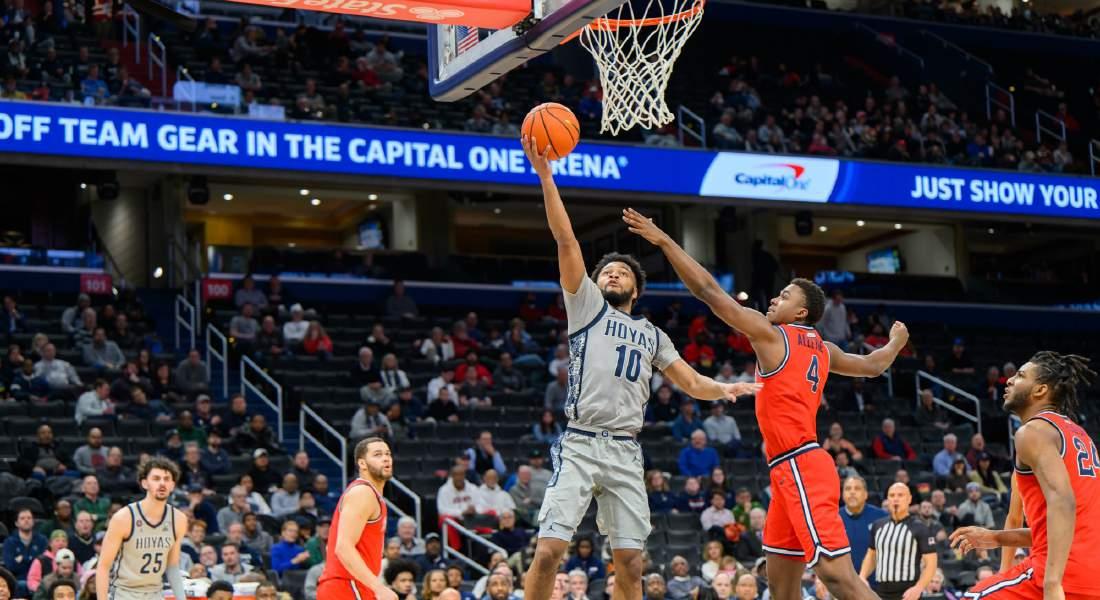
MBB, from A12 and one from sophomore guard Jayden Epps, respectively. With 1:21 remaining, a 3-point play from Fielder narrowed St. John’s lead to just seven points.
“I truly, truly believe the only thing that changed was our attitude, our effort and our energy,” Head Coach Ed Cooley told The Hoya in a postgame press conference. “It’s not like we had a magical play or came to the bench and had some super Gatorade. I don’t think we did anything different other than a will and a want.”
With the student section alive once again, Georgetown closed out the half on a 14-2 run, trailing St. John’s 39-32. Despite ending the first half on an 18-4 run, the Hoyas started the second half just as they did the first: slowly, torn apart on defense and unable to find consistency on offense. The Red Storm went on a
9-0 run over two minutes which put them up big once more, 58-41, with 13:03 left in the half. The Hoyas could have put their heads down, but they responded with 2 3-pointers, by Fielder and Bristol Jr., respectively, to cut the lead to 11 and keep Georgetown in the game.
Every time Georgetown scored to cut into the Red Storm’s lead, it seemed the opponents were ready to respond. Both teams kept finding the basket, and the Hoyas trailed by at least 9 points until 2:24 remained in the contest.
At that point, a 3 by Bristol Jr. cut the lead to 80-73 and kickstarted an 11-4 Georgetown run fueled by Epps’ playmaking. With 43 ticks remaining, Bristol Jr.’s third 3-pointer of the game brought the Hoyas within one possession for the first time in the second half.
It was there that Georgetown’s chances fizzled out, however. A fast-break dunk by St. John’s and a
missed 3 by Epps put the game out of reach for the Hoyas.
The Hoyas showed major improvement in 3-point shooting this game, converting an efficient 50% of their attempts from behind the arc for only the second time all season.
In fact, Georgetown’s offense was humming on all three levels, especially in the second half. The Hoyas scored 85 points, their second-highest points total in conference play this year, on 47% shooting, their best percentage against a Big East opponent thus far.
The Hoyas frequently turned to Epps to get them a bucket down the stretch, and more often than not he answered the call, leading all scorers in the game with 31 points, along with 7 assists. Brumbaugh, back in the starting lineup for the first time since Jan. 14 against UConn (24-3, 14-2 Big East), also impressed with 15 points and 7 assists. The problem for Georgetown, not-
withstanding their high offensive output, was that their defense remained porous from start to finish, unable to get stops when the team needed them most to claw back into the game.
“I’m disappointed in our overall defense. You score 85 points and lose. You’re supposed to win those games, right?” Cooley said. “It’s unfortunate that we’re not better defensively this late in the season, so the staff and I have to do a better job, and the players have to hold themselves accountable as well.”
As Georgetown prepares for its away game at DePaul (3-23, 0-15 Big East) on Feb. 24 at 6 p.m. — perhaps their best remaining chance of notching a second conference win — Cooley blended compassion and urgency in his mindset on the last five regular season games.
“I want us to play with some purpose, some energy, some love,” he said. “We need to win. I don’t give a damn if we play the Globetrotters, we need to win.”
KURTZ, from A12
“Everybody was eager to learn, and everybody was eager to get better,” Lasusa added. “So it’s important when you have a team come together and work really well with each other, because they can be there for each other and have each other’s backs in any moment.”
Georgetown’s cohesiveness immediately shined in the first matchup of the tournament against Bowdoin. After narrowly losing the first game of the set, Brownell rallied back 11-8, 11-6 and 11-5 to capture the win. From
that point on, the Hoyas won their next 24 consecutive games to earn the clean 9-0 sweep. William Smith, too, proved no match for the Hoyas. A tight 3-2 victory for Brownell set the stage for a 3-0 win by Jefferson and 3-1 wins by Kuthari and Schoonmaker. Lee, Kacergis, Hennessy, Bramen and Wilcox proceeded to sweep their sets for Georgetown’s second 9-0 match victory. “From a coach’s standpoint, that was the best mentally I had seen us the entire year, just throughout the weekend,” Lasusa said. “I think that allowed
each person to get the best out of themselves and be able to play the best squash that they could.” The finals, ultimately, were no different. The Hoyas won 24 games to the Ephs’ 11 for a 7-2 win to hoist the trophy. Ultimately, the goal is to continue building toward a national championship via recruiting and investment pathways — but for now, Georgetown can celebrate its accomplishments, transforming a club team into a legitimate contender in just three short years.
“Everyone is so committed to the Georgetown squash com-
munity,” Wilcox said. “The way squash has grown, how dedicated people are to this team even though everyone’s experience with it has been so different, that’s something I’m really excited to see in the future.”
“I couldn’t be happier,” Lasusa said. “I just think about the people that we’ve had so far, both from the beginning and end. For me, it’s about the group that we have and the community that we build. That, to me, is the most important part.”
“This was just a really awesome weekend, and I think it’s just an indication of more to come.”
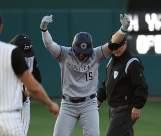

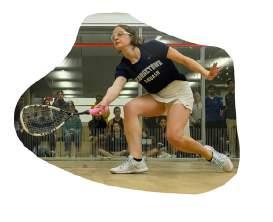
Georgetown @ Big East Championship
Friday, 12 p.m. Chicago, Ill.
 Daniel Greilsheimer Senior Sports Editor
Daniel Greilsheimer Senior Sports Editor
getting shots to fall led to a 10-0 St. John’s run and a score of 35-14 with 7:14 to go in the half.
Yet, just a few minutes later, a dunk from first-year center Drew Fielder with 4:35 to go shifted the momentum in favor of Georgetown. Nine consecutive points off 3-pointers followed, with 2 3s from first-year guard Rowan Brumbaugh
See MBB, A11
Perseverance is nothing new for Marina Paul (MSB ’16, GRD ’17), the founder of SPRHRA (pronounced super-he-ra), a sports apparel company designed by and for female athletes.
A five-year defender — and threeyear captain — for the Georgetown women’s soccer team, Paul helped catapult the program into the upper echelons of women’s collegiate soccer and to the top of the Big East standings, where the team perennially sits today.
But her journey as a Hoya was
anything but easy. She struggled with depression and eating disorders for much of her first year — in which she started every game — before tearing the same ACL in her right knee twice during her junior and senior years.
Paul returned to the Hilltop for her fifth year, albeit in the slightly different role of periodically coming off the bench. This forced Paul to relearn how to be a leader while not directly contributing to the team’s performance on the field.
Her final season, however, saw magical results, as the combination of a strong, dedicated group of depth players with a talented frontline
led to the program’s first Big East Tournament Championship and first College Cup semifinal appearance in history. After leaving Georgetown on such a high, Paul entered the business world, leading the marketing team at the startup Super Coffee, a company which offers healthy alternatives to traditional sugary coffee drinks, and later working as a consultant.
On top of that, Paul embarked on a book-writing journey in 2020, eventually publishing “Becoming a Superhero.” The novel intertwines lessons from her personal narrative
with the testimonies of other female leaders, including an Olympic gold medalist and the first Black woman to lead a men’s armed forces battalion.
The book also provided a framework for what would soon become SPRHRA, according to Paul.
“Writing through what I had experienced and connecting that and being like, ‘Okay, I think this is the playbook,’ and then, what resulted from that was building a sportswear company that I’ve always wanted to build,” Paul said.
As a result, after publishing “Becoming a Superhero” — from which the brand’s name SPRHRA
is derived — Paul began to set the foundation for her company, creating its first shorts samples while still working a day job.
The book also provided a framework for what would soon become SPRHRA, according to Paul.
“Writing through what I had experienced and connecting that and being like, ‘Okay, I think this is the playbook,’ and then, what resulted from that was building a sportswear company that I’ve always wanted to build,” Paul said. Oliver
Three
After rattling off three consecutive victories, the No. 15 Hoyas (14-8) won the Kurtz Cup, a single-elimination tournament between the 13th through 20th-ranked women’s teams in the nation, at the 2024 College Squash Association (CSA) Divisional Team Championships.
After sweeping the No. 18 Bowdoin Polar Bears (8-9) and No. 14 William Smith Herons (12-4) 9-0, Georgetown University clinched the chip in a 7-2 victory over the No. 16 Williams Ephs (12-11).
Head Coach Tim Lasusa said the Hoyas’ growth and perseverance throughout the season culminated in the team’s dominant showing this weekend.
“What made me so happy about this weekend was that we really just put everything all together,” Lasusa told The Hoya “We really dug deep in all those ups and downs that we’ve had throughout the year. They made us a lot better, and we came out this past week and did exactly what we had to do.”
Georgetown has steadily climbed the CSA Championship’s tier system, which is segmented by regular season rankings. After finishing as the runner-ups in the D and C divisions in the past two seasons,
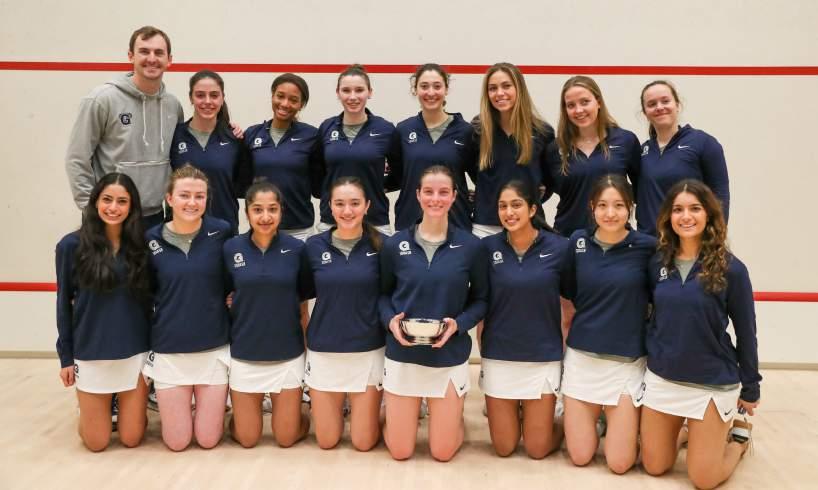
the Hoyas faced a formidable slate of games in the B division Kurtz Cup this year. “I like to equate it to the NIT for basketball,” Lasusa explained. The Hoyas had played all three playoff opponents in the regular season, defeating the Polar Bears and losing narrowly to the Herons and the Ephs. Senior captain Caroline Wilcox said the previous matches helped the team lock in on building a strong collective mentality for the tournament.
“Squash is a super mental
and Sydney Bramen, along with Wilcox, rounded out the squad. Wilcox, the only senior and remaining member from the inaugural squad in the 2021-22 season, said the team quickly developed a tight-knit community despite six of the nine starters being new arrivals to the program. “We became really close as a team,” Wilcox said. “In the beginning, it’s always hard to set the new dynamics, and it’s a completely different team than it was last year.”

Jack Lonergan Hoya Sports Columnist sport,” Wilcox told The Hoya. “Approaching nationals, we really focused on, ‘We know that we can play really good squash,’ so just making sure that we’re so locked in when approaching every match.” Graduate students Jesse Brownell and Brianna Jefferson, transfers from Dartmouth and Yale, respectively, formed a formidable one-two punch atop the lineup, while firstyears Aaru Kuthari, Ella Schoonmaker, Lindsay Lee and Mary Kacergis occupied the No. 3 through 6 positions. Sophomores Katie Hennessy
Portly men in garish shirts take turns throwing small missiles at a mosaicked wooden board. Then, another man (preferably bald with a raspy voice) shouts some numbers after doing simple addition.
Prior to December 2023, this is vaguely how I would describe darts to an inquirer. I understood the game easily enough, but did not “get” the sport in the slightest. For context, in my native British Isles, darts is a hugely popular sport that has rapidly outgrown its original pub roots, where it largely remains in the United States. Thousands watch it live, and millions more watch it on TV.
When I returned home over winter break, I expected the customary Christmas playlists and classic movies on TV, but all anyone was talking about were “the darts.” At least that is how it felt.
Since coming to Georgetown University, I have never felt more British, and I have found myself gravitating toward many British things that I had no connection to prior, whether that be Britpop or even comedy panel shows. However, my American heritage means some things are just too British for even me to buy into — and darts were at the top of that list.
Darts were first played 700 years ago in England when bored soldiers sat in trenches and threw spearheads at the bottoms of upturned wine casks. Their superiors encouraged the practice because it promoted useful skills, and soon, the soldiers began to compete. They used slices of tree trunks and aimed at certain zones determined by the trunks’ concentric circles, which eventually inspired the design of dartboards today.
Throughout the years, darts grew popular with nobility and common folk alike. Even Henry VIII was hooked, leading his wife Anne Boleyn to buy him an expensive set in an (eventually ill-fated) attempt to impress him.
Yet as the nobility began to favor sports that better demonstrated their wealth, such as polo and tennis, darts remained strong in pubs across the country and became a symbol of the working class. However, the sport would not be standardized until 1896 when a carpenter from Lancashire developed the now-famous scoring system of ringed sections indicating areas of double or triple point values.
But why on earth was it on my TV?
The first organized championships were in the 1920s, and darts first appeared on television in 1937. But it was in 1972, when the “World Individual Darts Championship” first aired, that professional darts transitioned from game to sport in the eyes of the media.